Articles
Ex-Dividend 29/12/2025
424823 December 26, 2025 17:39 ICMarkets Market News
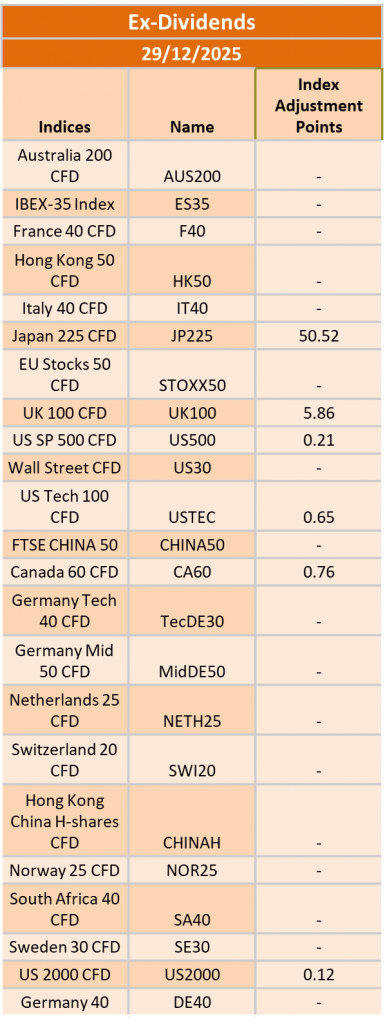
The post Ex-Dividend 29/12/2025 first appeared on IC Markets | Official Blog.
Ex-Dividend 25/12/2025
424818 December 24, 2025 16:39 ICMarkets Market News
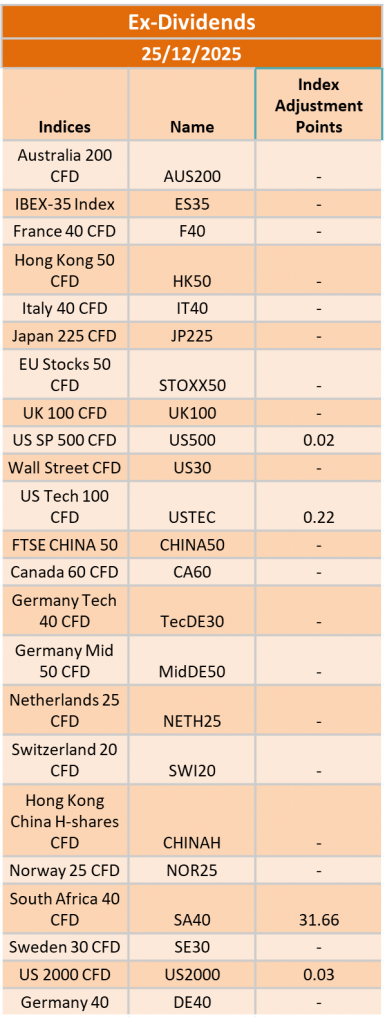
The post Ex-Dividend 25/12/2025 first appeared on IC Markets | Official Blog.
IC Markets Global – Europe Fundamental Forecast | 24 December 2025
424817 December 24, 2025 16:00 ICMarkets Market News
IC Markets Global – Europe Fundamental Forecast | 24 December 2025
What happened in the Asia session?
During today’s Asia session, markets traded off the prior US data pulse rather than any new high‑impact regional releases, with US Q3 GDP at 4.3% and softer durable goods framing a constructive “solid growth, moderating inflation” backdrop for risk assets. Asian equities, led by the Nikkei, Kospi and Hang Seng futures, largely followed Wall Street higher, while antipodean currencies outperformed the dollar, and USDJPY stayed sensitive to the recent BoJ shift and intervention rhetoric.
What does it mean for the Europe & US sessions?
Into today’s European and shortened U.S. session, the main tradable catalysts are U.S. weekly jobless claims and housing/mortgage data, set against a backdrop of modestly dovish Fed commentary, limited 2025 rate‑cut pricing, and still‑elevated equity indices. European data are mostly second‑tier sentiment prints, so the dollar, front‑end Treasury yields, and U.S. equities are likely to drive the cross‑asset tone, with any labour-market softness quickly reviving rate‑cut expectations and pressuring the dollar.
The Dollar Index (DXY)
Key news events today
Unemployment Claims (1:30 pm GMT)
What can we expect from DXY today?
The Dollar heads into Wednesday on the back foot, with the Dollar Index hovering just under 98 after weeks of steady declines driven by expectations of Fed rate cuts in 2026 and a broader shift away from Dollar strength. Resilient U.S. growth data have not altered this narrative, as markets instead price in a softer policy path and anticipate some cooling in the labor market next year, leaving EUR, GBP, and CHF modestly stronger while USD/CAD stabilizes.
Central Bank Notes:
- The Federal Open Market Committee (FOMC) is widely expected to lower the federal funds rate target range by 25 basis points to 3.50%–3.75% at its December 9–10, 2025, meeting, marking the third consecutive cut after the October reduction to 3.75%–4.00%
- The Committee continues to pursue maximum employment and 2% inflation goals, with the labour market showing further softening as the unemployment rate rose to 4.4% in September 2025 amid modest job gains.
- Officials note persistent downside risks to growth alongside resilient activity, with inflation easing to 3.0% year-over-year CPI in September but remaining elevated due to tariff effects; core PCE stands at around 2.8% as of October.
- Economic activity grew at a 3.8% annualised pace in Q2 2025, according to revised estimates. However, Q3 and Q4 are expected to face headwinds from trade tensions, fiscal restraint, and data disruptions, such as the government shutdown.
- September’s Summary of Economic Projections forecasts 2025 unemployment at a median 4.5%, with PCE inflation near 3.0% and core PCE at 3.1%, signalling a gradual disinflation path; updates expected on December 10 may adjust for higher unemployment and lower growth.
- The Committee maintained its data-dependent approach, noting a softening labour market and inflation above the 2% target, while deciding to lower the federal funds rate target range by 25 basis points to 3.50%-3.75%. Dissent persisted, with multiple members opposing the cut or advocating for a hold, reflecting divisions similar to recent meetings.
- The FOMC confirmed the conclusion of its quantitative tightening program effective December 1, 2025, with Treasury rolloff caps at $5 billion per month and agency MBS caps at $35 billion per month to ensure ample reserves and market stability.
- The next meeting is scheduled for 27 to 28 January 2026.
Next 24 Hours Bias
Medium Bearish
Gold (XAU)
Key news events today
Unemployment Claims (1:30 pm GMT)
What can we expect from Gold today?
Gold is extending its extraordinary 2025 rally today, trading just under or around 4,500 USD per ounce after notching fresh all‑time highs in recent sessions. The move reflects intense safe‑haven demand, expectations of rate cuts, and a weaker dollar, which together have pushed the metal roughly 70% higher year‑to‑date and about 9% over the last month.
Next 24 Hours Bias
Strong Bullish
The Euro (EUR)
Key news events today
No major news event
What can we expect from EUR today?
Going into Wednesday, the euro is trading on a firm footing, with EUR/USD hovering near late‑December highs around the upper‑1.17s after reaching its strongest level of the month on 23 December. The latest ECB meeting left rates unchanged, but upgraded growth projections to roughly 1.4% for 2025 and confirmed that inflation is moving closer to target, convincing markets that policy is effectively on hold and that the bar for fresh cuts is high.
Central Bank Notes:
- The Governing Council of the ECB is widely expected to keep the three key interest rates unchanged at its 17–18 December 2025 meeting, maintaining the main refinancing rate at 2.15%, the marginal lending facility at 2.40% and the deposit facility at 2.00%. This would reflect policymakers’ assessment that the current policy stance remains broadly consistent with medium‑term price stability, while inflation hovers close to the 2% target and the economy expands at a modest pace. Market pricing and recent ECB commentary suggest a high “option value” in staying on hold, with no clear pre‑set path for the next move amid two‑sided risks around growth and inflation.
- Recent indicators point to broadly stable price dynamics around the ECB’s target. Headline HICP inflation is projected to hover near 2% through late 2025, with earlier energy‑related disinflation largely behind and food price pressures contained compared with previous years. Services and wage inflation remain somewhat firmer than anticipated, but the trend is one of gradual moderation, consistent with a scenario in which inflation stabilizes around but not persistently above 2% over the medium term.
- Eurosystem staff projections to be released in December are expected to show only small revisions from the September exercise, maintaining a profile of headline inflation close to 2% in 2025, dipping slightly below in 2026, and returning near target in 2027. Soft producer prices, fading pipeline cost pressures, and anchored long‑term inflation expectations limit upside risks, though officials continue to flag uncertainty from geopolitical tensions, commodity price shocks, and fiscal policy choices.
- Euro area GDP growth remains subdued but resilient, with most forecasters and survey‑based indicators pointing to an expansion around 1 — 1.25% in 2025 and 2026, followed by a similar pace into 2027. PMIs and confidence surveys suggest activity has stabilised after earlier weakness, with modest support from public investment and improving external demand offsetting soft private consumption and investment.
- The labour market remains tight in aggregate, with unemployment rates close to multi‑decade lows and participation relatively high, even as job creation has slowed from its earlier peak. Real income growth has turned slightly positive again as inflation normalises, underpinning household spending, while financing conditions, though tighter than in the pre‑hiking era, remain consistent with a gradual expansion in credit to households and firms.
- Business sentiment is mixed, reflecting uncertainty around global trade, the policy outlook in the United States, and the potential impact of future tariff or industrial policy shifts. At the same time, easing supply‑chain costs and a relatively competitive euro exchange rate versus major trading partners provide support to manufacturing and export‑oriented sectors at the margin.
- The Governing Council is expected to reiterate that future decisions will remain data-dependent and taken meeting by meeting, based on an integrated assessment of the inflation outlook, the dynamics of underlying inflation, and the strength of monetary policy transmission. Officials have recently stressed that both further hikes and eventual cuts remain contingent on incoming data, implying no commitment to a particular path and a readiness to adjust if inflation or growth diverge materially from baseline projections.
- Balance sheet normalisation is set to continue gradually and predictably, with the stock of assets under the APP and PEPP declining as reinvestments have already been halted or scaled back in line with prior guidance. The ECB is expected to confirm that the current pace of portfolio runoff remains appropriate, supporting a slow withdrawal of monetary accommodation without disrupting market functioning.
- The next meeting is on 4 to 5 January 2026
Next 24 Hours Bias
Medium Bullish
The Swiss Franc (CHF)
Key news events today
No major news event
What can we expect from CHF today?
The Swiss franc enters Wednesday in a position of continued strength, with USD/CHF trading just under 0.79 amid a clear short‑term bearish structure for the pair. The SNB’s decision to hold rates at 0% while inflation undershoots and the economy stabilizes, combined with persistent safe‑haven flows linked to global and US policy uncertainty, is keeping CHF well bid against the dollar and limiting upside in USD/CHF.
Central Bank Notes:
- At its 11 December 2025 monetary policy assessment, the Swiss National Bank (SNB) is widely expected to leave the policy rate unchanged at 0%, extending the pause that began in September as the Governing Board judges that current settings are sufficient to keep inflation near, but still below, its target while avoiding an unnecessary move into negative rates.
- Recent data show that the tentative rebound in Swiss inflation has stalled, with headline CPI easing from 0.1% year‑on‑year in October to 0.0% in November and core inflation slipping to about 0.4%, reinforcing the view that underlying price pressures remain very weak and that deflation risks, while contained, have not fully disappeared.
- The SNB’s conditional inflation forecast is likely to remain close to the September projections, with inflation still seen averaging roughly 0.2% in 2025, 0.5% in 2026, and 0.7% in 2027 under an unchanged policy rate path, though the latest CPI prints argue for a slightly lower near‑term profile and keep open the option of renewed easing if activity or prices weaken further.
- The global backdrop has deteriorated further, as continuing U.S. tariff actions and softer external demand weigh on world trade, while uncertainty in key European and U.S. markets for Swiss exports persists, leaving the SNB cautious about the growth outlook despite Switzerland’s relatively resilient domestic demand.
- Business and labour-market sentiment in export‑oriented manufacturing remains subdued, with firms reporting pressure on margins from the still‑strong franc and softer foreign orders, although the broader economy is still expected to grow at around 1–1.5% in 2025 and unemployment only drifting up gradually from low levels.
- The SNB continues to stress its willingness to act if deflation risks re‑emerge, reiterating that it can ease policy through renewed rate cuts or targeted foreign‑exchange intervention if necessary, while also highlighting its commitment to transparent communication, including the publication of detailed minutes from recent assessments and ongoing dialogue with international partners on FX policy
The next meeting is on 19 March 2026.
Next 24 Hours Bias
Medium Bullish
The Pound (GBP)
Key news events today
No major news event
What can we expect from GBP today?
The Pound is trading firm into holding just below the 1.35 handle against the US Dollar as year‑end dollar softness and a relatively hawkish Bank of England backdrop keep GBP supported. GBP/USD is hovering around 1.348 — 1.349 after touching its highest levels in roughly 11 weeks, with the spot quoted near 1.3489 on 23 December and only modestly off that level in late Tuesday trade.
Central Bank Notes:
- The Bank of England’s Monetary Policy Committee (MPC) will meet on 18 December 2025, with the current Bank Rate standing at 4.00 per cent after being held in a close 5–4 vote at the 5 November meeting. Market pricing and analyst commentary point to a high risk of a 25‑basis‑point cut to 3.75 per cent, but this remains conditional on incoming inflation and labour‑market data, so the December note should be treated as pre‑decision guidance rather than an ex‑post summary.
- The BoE is expected to leave its quantitative tightening (QT) framework broadly unchanged through year‑end, maintaining the lower reduction pace in gilt holdings that was set earlier in 2025. Official communications still characterise the existing QT path as consistent with a restrictive stance, with policymakers stressing that balance‑sheet reduction will remain gradual and sensitive to market‑liquidity conditions.
- Headline CPI inflation eased to 3.6 per cent year‑on‑year in October 2025, down from 3.8 per cent in September, helped by softer energy and goods prices, though it remains almost twice the 2 per cent target. Underlying inflation pressures, particularly in services, have continued to moderate only slowly, so the MPC’s central projection still envisages inflation moving closer to, but not yet reaching, 3 per cent over the course of 2026, contingent on further normalisation in energy and wage dynamics.
- UK economic activity remains weak heading into the December meeting, with the labour market showing further signs of slackening. The unemployment rate has risen toward just above 5 per cent on the latest three‑month figures to October, while overall regular pay growth has slowed to around the mid‑4 per cent range, reinforcing the view that domestic cost pressures are gradually easing.
- External conditions continue to cloud the outlook, with fragile global growth and fluctuating commodity prices contributing to bouts of financial‑market volatility. The MPC has highlighted that renewed global energy or food price shocks could temporarily slow the pace of disinflation, but such risks are currently judged unlikely to derail the medium‑term downward trajectory for inflation if domestic demand stays subdued.
- The balance of risks around the inflation outlook remains finely poised. Downside risks are linked to persistently weak domestic demand and rising unemployment, while upside risks come from still‑elevated inflation expectations, sticky services inflation, and the possibility that structural changes in the labour market leave less slack than conventional indicators suggest.
- Overall, the MPC’s stance going into December is restrictive but increasingly open to a gradual easing cycle, with any rate cuts expected to be measured and data‑dependent. Policymakers have reiterated that the Bank Rate will need to stay in restrictive territory until they are confident inflation is on a sustainable path back to the 2 per cent target, and they have signalled that the profile of cuts, once started, is likely to be shallow rather than rapid.
- The next meeting is on 5 February 2026.
Next 24 Hours Bias
Medium Bullish
The Canadian Dollar (CAD)
Key news events today
No major news event
What can we expect from CAD today?
Today, the Canadian dollar is trading modestly stronger in a relatively quiet pre‑holiday session, keeping USD/CAD around the mid‑1.36s–1.37s after touching a five‑month low near 1.3675 on rising Fed rate‑cut expectations. Recent Canadian GDP data showed a 0.3% contraction in October, but the loonie actually inched higher as markets viewed the release as consistent with the Bank of Canada’s cautious, hold‑for‑now stance.
Central Bank Notes:
- The Governing Council left the target for the overnight rate unchanged at 2.25% at its 10 December 2025 meeting, in line with market expectations and signalling that the earlier easing cycle has likely concluded. The Bank noted that while global tariff tensions and trade uncertainty persist, the external backdrop has stabilised somewhat, reducing the need for additional insurance cuts even as world trade remains fragile.
- The Council acknowledged that uncertainty around U.S. trade policy and tariffs continues to weigh on business sentiment, but recent data show Canadian manufacturing and goods exports holding up better than anticipated. Surveys cited by the Bank suggest export order books have stopped deteriorating, with firms reporting some rebuilding of backlogs despite still‑cautious capital spending plans.
- Canada’s economy rebounded more strongly than expected in the third quarter, with real GDP expanding at an annualised pace of about 2.6% after a 1.8% contraction in Q2, largely on the back of higher crude exports and government spending. Monthly data show output rising 0.2% in September, though flash estimates point to a softer start to Q4 as some sectors give back earlier gains.
- Service sector activity has firmed, with indicators showing the services PMI back above the 50 threshold and broadening gains in business and professional services. However, consumer-facing categories remain mixed, as still‑elevated price levels and only modest real income growth keep a lid on discretionary spending even as tourism and technology‑related services expand.
- Housing markets have continued to stabilise, with national resale activity and prices edging higher through the autumn alongside the earlier decline in borrowing costs. The Bank noted that while some major urban centres are seeing renewed price pressures, tighter underwriting standards and still‑high affordability constraints are expected to cap the pace of any rebound.
- Headline CPI inflation eased to 2.2% year over year in October and is estimated to have remained near that rate in November, keeping it slightly above the 2% target but comfortably within the 1%–3% control range. Core measures have drifted lower, with CPI‑median and CPI‑trim around 3% or below, reinforcing the assessment that underlying price pressures are gradually moderating even as gasoline and some shelter components remain volatile.
- The Governing Council reiterated that the current policy rate is “about the right level” to keep inflation close to target while supporting the economy through a period of structural adjustment, and it signalled a shift away from near‑term easing expectations. While the Bank did not rule out future adjustments, officials stressed that, barring a material downside surprise to growth or inflation, further rate cuts are unlikely before 2026, and attention is now focused on the durability of the recovery and the evolution of core inflation.
- The next meeting is on 28 January 2026.
Next 24 Hours Bias
Medium Bullish
Oil
Key news events today
EIA Crude Oil Inventories (2:30 pm GMT)
What can we expect from Oil today?
Oil prices are edging higher on Wednesday, with Brent holding just above 62 USD and WTI around the high‑50s as the market extends a five‑day rally driven by stronger US economic data and renewed supply risk premium. The up-move follows a deep year-on-year decline in prices amid robust OPEC and non‑OPEC output and inventories that remain above last year but below the 2015–2019 norm, signalling a market that is better supplied but not oversaturated.
Next 24 Hours Bias
Medium Bearish
The post IC Markets Global – Europe Fundamental Forecast | 24 December 2025 first appeared on IC Markets | Official Blog.
IC Markets Global – Asia Fundamental Forecast | 24 December 2025
424816 December 24, 2025 16:00 ICMarkets Market News
IC Markets Global – Asia Fundamental Forecast | 24 December 2025
What happened in the U.S. session?
During the latest U.S. session, the dominant theme was a stronger‑than‑expected growth print against a backdrop of still‑sticky inflation, which kept equities hovering near records but capped further upside as traders recalibrated Fed easing hopes. Growth‑sensitive assets such as copper and cyclicals found support, while rate‑sensitive instruments, including index futures and the dollar, adjusted to a “higher for longer” policy narrative even as safe‑haven metals like gold continued to benefit from broader macro and geopolitical risks.
What does it mean for the Asia Session?
Asian traders on Wednesday will be trading into a thin, holiday‑shortened session, with attention on Japan’s data and BoJ operations, early closures in Hong Kong, and positioning ahead of key U.S. GDP and jobless claims later in the week. Risk sentiment in Asia is broadly constructive but muted, with recent gains in regional equities supported by prior strength in U.S. tech and AI names and expectations of a calm year‑end despite holiday‑thinned liquidity.
The Dollar Index (DXY)
Key news events today
Unemployment Claims (1:30 pm GMT)
What can we expect from DXY today?
Into Wednesday, the Dollar is on the back foot, with the Dollar Index trading just below 98 and sitting near an 11‑week low after a 2% monthly and roughly 9% yearly slide, as cooling US inflation bolsters expectations for further Fed rate cuts and encourages investors to rotate into other currencies and safe‑haven assets. In the majors, EUR/USD is holding an upward trend around 1.17 with scope to retest 1.18, while GBP/USD trades above 1.34 with the 1.35–1.36 zone in view, reflecting the Dollar’s broad underperformance in G10 FX
Central Bank Notes:
- The Federal Open Market Committee (FOMC) is widely expected to lower the federal funds rate target range by 25 basis points to 3.50%–3.75% at its December 9–10, 2025, meeting, marking the third consecutive cut after the October reduction to 3.75%–4.00%
- The Committee continues to pursue maximum employment and 2% inflation goals, with the labor market showing further softening as the unemployment rate rose to 4.4% in September 2025 amid modest job gains.
- Officials note persistent downside risks to growth alongside resilient activity, with inflation easing to 3.0% year-over-year CPI in September but remaining elevated due to tariff effects; core PCE stands at around 2.8% as of October.
- Economic activity grew at a 3.8% annualized pace in Q2 2025 per revised estimates, though Q3 and Q4 face headwinds from trade tensions, fiscal restraint, and data disruptions like the government shutdown.
- September’s Summary of Economic Projections forecasts 2025 unemployment at a median of 4.5%, with PCE inflation near 3.0% and core PCE at 3.1%, signaling a gradual disinflation path. Updates expected on December 10 may adjust for higher unemployment and lower growth.
- The Committee maintained its data-dependent approach, noting a softening labor market and inflation above the 2% target, while deciding to lower the federal funds rate target range by 25 basis points to 3.50%-3.75%. Dissent persisted, with multiple members opposing the cut or advocating for a hold, reflecting divisions similar to recent meetings.
- The FOMC confirmed the conclusion of its quantitative tightening program effective December 1, 2025, with Treasury rolloff caps at $5 billion per month and agency MBS caps at $35 billion per month to ensure ample reserves and market stability.
- The next meeting is scheduled for 27 to 28 January 2026.
Next 24 Hours Bias
Medium Bearish
Gold (XAU)
Key news events today
Unemployment Claims (1:30 pm GMT)
What can we expect from Gold today?
Gold is entering Wednesday, trading just below its recent record highs above 4,400 USD per ounce, with XAUUSD holding a strong uptrend after clearing key resistance and riding a 70%‑plus year‑on‑year surge. The move remains driven by expectations of further US rate cuts, a softer dollar, intense central‑bank and ETF demand, and ongoing geopolitical tensions that keep safe‑haven interest elevated even as holiday liquidity dampens intraday volatility.
Next 24 Hours Bias
Strong Bullish
The Australian Dollar (AUD)
Key news events today
No major news event
What can we expect from AUD today?
Into Wednesday, the Australian dollar is holding near recent highs against the US dollar, trading in the mid‑0.66s after a roughly 3% monthly and 6–7% yearly appreciation, but facing persistent resistance around 0.67 as holiday‑thinned markets curb follow‑through. The backdrop is a mix of modest Australian growth, sticky but easing inflation, and a softening labour market, set against expectations that the Federal Reserve will eventually tilt more dovishly, which together have supported AUD while keeping traders sensitive to downside risks if global risk appetite fades or key supports in the low‑0.64s give way.
Central Bank Notes:
- The Reserve Bank of Australia held its cash rate steady at 3.60% at the November 2025 policy meeting, adopting a cautious tone amid a surprise uptick in inflation data for the September quarter. This marks the fourth consecutive pause since the 25 basis point cut in August. The Board attributed some of the inflation rise to temporary factors like higher petrol prices and council rates, but noted signs of more persistent pressures from consumer demand.
- Policymakers emphasized vigilance on inflation, with trimmed mean inflation expected to remain elevated in the near term before nearing the 2–3% target midpoint by mid-2027. Recent data showed underlying inflation staying above target until at least the second half of 2026, prompting upward revisions to forecasts. Capacity pressures are seen as slightly more pronounced than previously assessed, delaying any easing.
- Headline CPI for the September quarter exceeded expectations, driven partly by temporary items, while underlying measures signal ongoing stickiness. The shift to monthly CPI reporting, with the first full edition in November 2025, will enhance real-time inflation monitoring. Housing and services remain resilient contributors to price pressures.
- Domestic demand shows firmness in services alongside below-trend growth elsewhere, with capacity pressures not expected to ease significantly. The labor market is gradually softening, with unemployment projected to stabilize around 4.4%, though wage growth and productivity dynamics keep unit labor costs a concern. Household spending faces headwinds from high borrowing costs.
- Global risks include geopolitical tensions and commodity volatility, set against modestly revised-up world growth outlooks. The Board describes its policy as mildly restrictive and data-dependent, balancing inflation control with employment goals. No rate hike was considered despite the inflation surprise.
- Monetary policy remains mildly restrictive to address lingering price stability risks amid household and global vulnerabilities. Communications reaffirm the dual mandate of 2–3% inflation and full employment, with readiness to adjust based on incoming data.
- Market expectations point to the cash rate holding through early 2026, with a possible modest cut to 3.3% mid-year if inflation eases as forecast. The new monthly CPI data will be key for timely insights.
- Monetary policy remains mildly restrictive, balancing progress on price stability against vulnerabilities in household demand and global outlook. Board communications reaffirm a dual mandate: price stability and full employment, while underscoring readiness to respond should risks materialize sharply.
- Analysts generally expect the cash rate to remain at current levels through early 2026, with only modest cuts possible later in the year if inflation moderates. The new monthly CPI release (first full edition Nov 2025) will be watched closely for timely signals on price trends.
- The next meeting is on 2 to 3 February 2026.
Next 24 Hours Bias
Medium Bullish
The Kiwi Dollar (NZD)
Key news events today
No major news event
What can we expect from NZD today?
Into Wednesday, the Kiwi is trading with a slightly positive bias but without a clear breakout, as solid Q3 growth and supportive regulatory tweaks are offset by the RBNZ’s commitment to keep rates on hold well into 2026 and by generally firm global dollar conditions. This leaves NZD priced for a cautious recovery: supported on dips by improving domestic data and expectations that easier bank capital rules will gradually filter into cheaper credit, yet capped on rallies by central‑bank rhetoric that downplays the prospect of near‑term tightening.
Central Bank Notes:
- The Monetary Policy Committee (MPC) left the Official Cash Rate (OCR) unchanged at 2.25% at its 26 November 2025 meeting, following the widely anticipated 25-basis-point reduction from 2.50%, and signaled that policy is now firmly in stimulatory territory while keeping the option of further easing on the table if needed.
- The decision was again reached by consensus, with members judging that the cumulative 325 basis points of easing over the past year warranted a period of assessment, even as several emphasized a willingness to cut further should incoming data point to a more protracted downturn or renewed disinflationary pressures.
- Headline consumer price inflation is projected to hover near 3% in late 2025 before gradually easing toward the 2% midpoint of the 1–3% target band through 2026, supported by contained inflation expectations around 2.3% over the two-year horizon and an expected pickup in spare capacity.
- The MPC noted that domestic demand remains subdued but shows tentative signs of stabilisation, with softer household spending and construction only partially offset by improving services activity; nevertheless, policymakers still expect services inflation to ease as wage growth moderates and the labour market loosens further over the coming year.
- Financial conditions continue to ease as wholesale and retail borrowing rates reprice to the lower OCR, contributing to gradually rising mortgage approvals and improving housing-related sentiment, although broader business credit growth remains patchy and sensitive to uncertainty about the durability of the recovery.
- Recent data confirm that GDP momentum is weak but not deteriorating as sharply as earlier in 2025, with high-frequency indicators pointing to a shallow recovery from a low base and ongoing headwinds from elevated living costs and fragile confidence weighing on discretionary consumption and investment.
- The MPC reiterated that external risks remain skewed to the downside, particularly from softer Chinese demand and uncertainty around United States trade policy, but noted that a lower New Zealand dollar continues to provide some offset via improved export competitiveness and support for tradables inflation.
- Looking ahead to early 2026, the Committee maintained a mild easing bias, indicating that a further cut toward 2.00–2.10% cannot be ruled out if activity fails to gain traction or if inflation undershoots projections, but current forecasts envisage the OCR remaining near 2.25% for an extended period provided inflation converges toward target and the recovery proceeds broadly as expected.
- The next meeting is on 18 February 2026.
Next 24 Hours Bias
Medium Bullish
The Japanese Yen (JPY)
Key news events today
No major news event
What can we expect from JPY today?
The Japanese yen is stabilizing and modestly firmer after officials in Tokyo delivered their strongest verbal warnings yet that recent yen weakness is out of line with fundamentals, pushing USD/JPY back toward the mid‑150s after it flirted with higher levels post‑BoJ. The backdrop is a BoJ that has finally lifted rates to a three‑decade high but is signalling only gradual further tightening, so wide yield gaps with the US remain, and speculative yen selling is still attractive on rallies.
Central Bank Notes:
- The Policy Board of the Bank of Japan will meet on 18–19 December with markets almost fully pricing a 25-basis-point hike, which would raise the short-term policy rate from 0.50% to around 0.75%, as the bank moves further away from its ultra-loose stance while stressing that any tightening will remain gradual and data-dependent.
- The BOJ is expected to continue guiding the uncollateralized overnight call rate in a narrow band around the new policy rate, near 0.75%, while signaling that the pace and timing of any additional hikes will depend on how past increases affect bank lending, corporate financing conditions, and overall economic activity.
- The quarterly path of JGB purchases remains on a pre-announced, gradual taper: outright purchases are being reduced by about ¥400 billion per quarter through March 2026, then by roughly ¥200 billion per quarter from April to June 2026, with the bank still aiming for JGB purchases to settle near ¥2 trillion in Q1 2027 and retaining flexibility to adjust the pace if market functioning or yield volatility deteriorate.
- Japan’s economy has softened in the near term, with Q3 2025 GDP contracting at an annualized pace of about 2.3% as weaker residential investment and external demand weighed on activity, even as business sentiment in manufacturing has recently improved to a roughly four-year high.
- Core consumer inflation (excluding fresh food) accelerated to around 3.0% year-on-year in October, up from 2.9% in September and remaining above the BOJ’s 2% target, while the “core-core” measure excluding both fresh food and energy rose to about 3.1%, underscoring persistent underlying price pressures.
- In the very near term, some input-cost pressures are easing as earlier import price surges fade, but services inflation linked to labor shortages, along with steady wage gains, continues to support broader price momentum; firms’ and households’ medium-term inflation expectations remain anchored slightly above 2%, keeping short-term inflation risks tilted to the upside.
- For the coming quarters, the BOJ assesses that real growth will likely run below potential as the economy digests tighter financial conditions and past yen depreciation, though accommodative real rates, positive real wage growth, and improving corporate sentiment should help sustain a modest recovery in private consumption and business investment.
- Over the medium term, as overseas demand stabilizes and domestic labor markets remain tight, the BOJ expects wage settlements and inflation expectations to keep core inflation on a gradual upward trajectory around or slightly above 2%, providing room for further cautious rate normalization as long as financial conditions remain supportive and the recovery is not derailed.
- The next meeting is scheduled for 22 to 23 January 2026.
Next 24 Hours Bias
Medium Bullish
Oil
Key news events today
EIA Crude Oil Inventories (2:30 pm GMT)
What can we expect from Oil today?
Oil prices have firmed over the past couple of sessions after U.S. forces boarded a Venezuelan tanker and moved against another vessel, reigniting concerns about potential supply disruptions from that country and lifting both Brent and WTI by more than 2% on the previous trading day. As of late December 23, Brent was just under 62 USD per barrel while WTI hovered around 58 USD, but both benchmarks remain down roughly 15–17% year‑on‑year and have traded in a relatively tight range for most of 2025, reflecting an oversupplied market and “jaded” risk appetite despite geopolitical headlines.
Next 24 Hours Bias
Medium Bearish
The post IC Markets Global – Asia Fundamental Forecast | 24 December 2025 first appeared on IC Markets | Official Blog.
Wednesday 24th December 2025: Asian Markets Trade Mixed Amid Thin Holiday Volumes
424815 December 24, 2025 15:39 ICMarkets Market News
Global Markets:
- Asian Stock Markets : Nikkei up 0.13%, Shanghai Composite up 0.24%, Hang Seng up 0.13% ASX down 0.38%
- Commodities : Gold at $4,522.25 (0.37%), Silver at $72.313 (1.65%), Brent Oil at $62.49 (0.18%), WTI Oil at $58.49 (0.19%)
- Rates : US 10-year yield at 4.158, UK 10-year yield at 4.5110, Germany 10-year yield at 2.8647
News & Data:
- (CAD) GDP m/m -0.3% to -0.3% expected
- (USD) Prelim GDP q/q 4.3% to 3.3% expected
Markets Update:
Asian stock markets are showing a mixed performance on Wednesday, with trading volumes remaining thin across most of the region as several markets are set to close early today and remain shut on Thursday for the Christmas holiday. Positive cues from Wall Street have helped limit losses, after the S&P 500 closed at a record high overnight, supported by stronger-than-expected U.S. third-quarter GDP growth data.
The Australian market is trading lower, weighed down mainly by weakness in banking stocks. The session will end early at 2:10 p.m. local time, with markets closed on Thursday and Friday for Christmas and Boxing Day. The S&P/ASX 200 Index is down 0.38 percent at 8,762.70, while the broader All Ordinaries Index is lower by about 0.3 percent at 9,069. Major banks including National Australia Bank, Westpac, Commonwealth Bank and ANZ Bank are all trading in negative territory, losing between 0.4 and 1 percent. Mining stocks are providing some support, helped by firmer metal prices, with BHP, Fortescue Metals and Rio Tinto posting gains. Shares of Monash IVF plunged more than 11 percent after a consortium withdrew its takeover offer.
Japanese equities are trading modestly higher, although gains are capped by expectations of further interest rate hikes by the central bank. The Nikkei 225 is up about 0.1 percent, with strong gains in select metal, technology and electronics stocks.
Elsewhere in the region, China’s Shanghai Composite is up 0.16 percent, Hong Kong’s Hang Seng is gaining around 0.15 percent, and South Korea’s KOSPI is marginally higher. New Zealand stocks are slightly higher, while markets in Singapore, Malaysia and Indonesia are trading weaker.
Upcoming Events:
- 01:30 PM GMT – USD Unemployment Claims
The post Wednesday 24th December 2025: Asian Markets Trade Mixed Amid Thin Holiday Volumes first appeared on IC Markets | Official Blog.
Wednesday 24th December 2025: Technical Outlook and Review
424802 December 24, 2025 15:39 ICMarkets Market News
DXY (U.S. Dollar Index):
Potential Direction: Bearish
Overall momentum of the chart: Bearish
The price has already reacted off the pivot and may continue its bearish move toward the 1st support.
Pivot: 98.13
Supporting reasons: Identified as an overlap resistance, where selling pressures could intensify and potentially cap any upward retracement.
1st support: 97.35
Supporting reasons: Identified as a swing low support that aligns with the 161.6% Fibonacci extension, indicating a potential area where the price could again stabilize.
1st resistance: 98.77
Supporting reasons: Identified as an overlap resistance, indicating a potential area that could halt any further upward movement
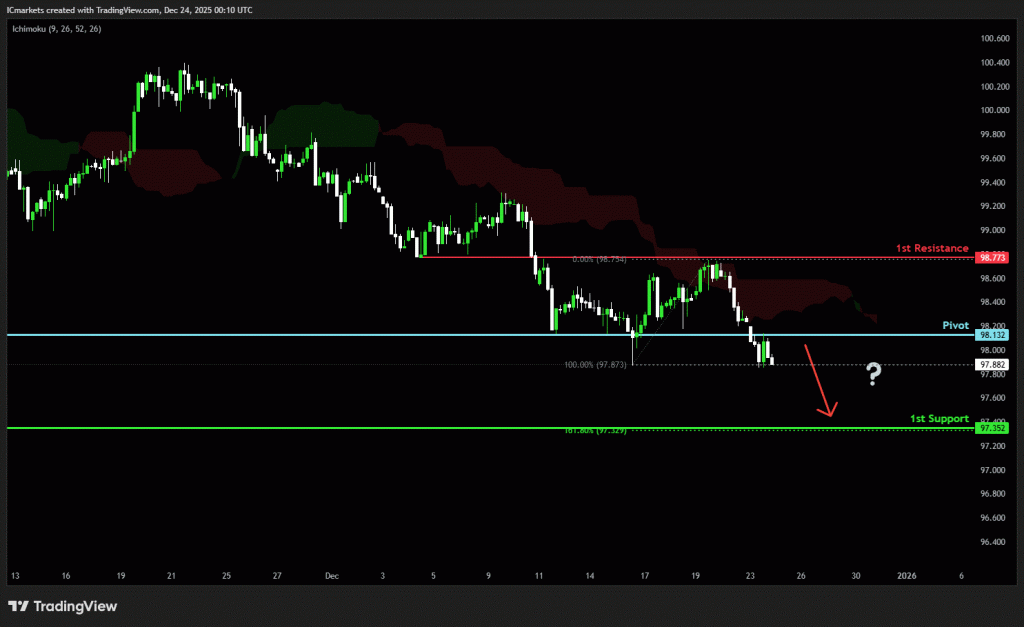
EUR/USD:
Potential Direction: Bullish
Overall momentum of the chart: Bearish
The price could see a short-term pullback toward the pivot before rising again toward the 1st resistance.
Pivot: 1.1751
Supporting reasons: Identified as a pullback support, where renewed buying pressure could emerge to push the price higher.
1st support: 1.1712
Supporting reasons: Identified as an overlap support, indicating a potential level where the price could stabilize once again.
1st resistance: 1.1866
Supporting reasons: Identified as a swing high resistance that aligns closely with the 161.8% Fibonacci extension, indicating a potential level that could cap further upward movement.
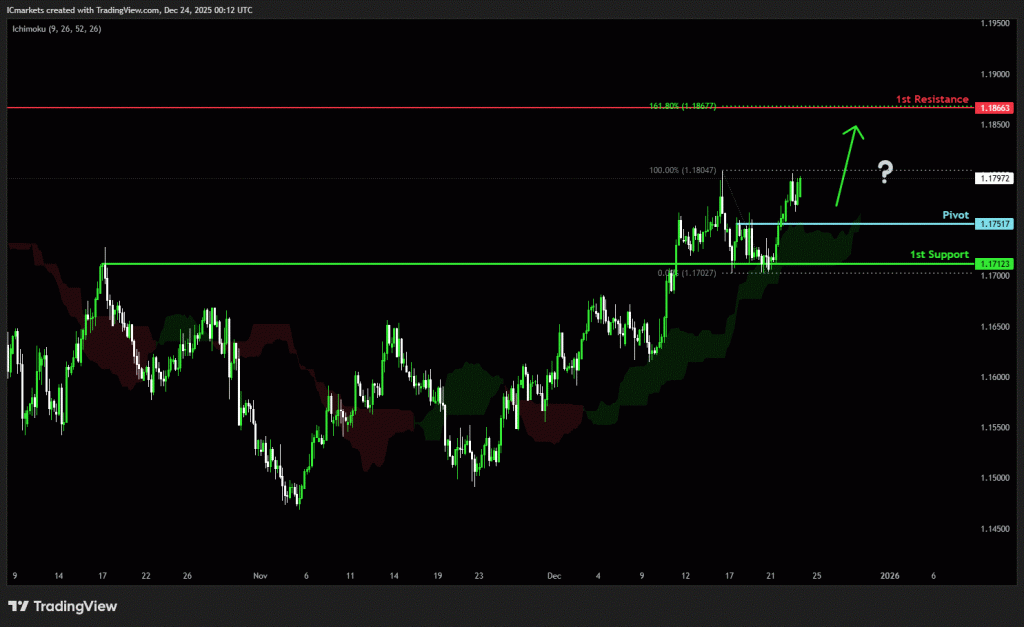
EUR/JPY:
Potential Direction: Bullish
Overall momentum of the chart: Bullish
The price could see a short-term pullback toward the pivot before rising again toward the 1st resistance.
Pivot: 183.02
Supporting reasons: Identified as a pullback support, where renewed buying pressure could emerge to push the price higher.
1st support: 181.69
Supporting reasons: Identified as a pullback support, indicating a potential area where the price could again stabilize.
1st resistance: 184.71
Supporting reasons: Identified as a swing high resistance that is supported by the 100% Fibonacci extension, indicating a potential level that could cap further upward movement.
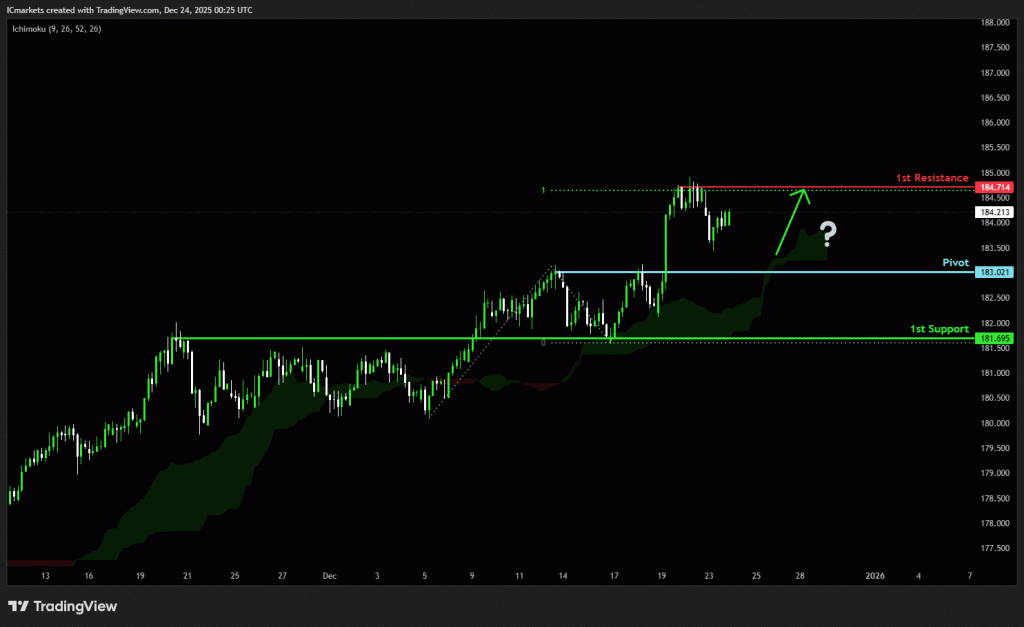
EUR/GBP:
Potential Direction: Bearish
Overall momentum of the chart: Bullish
The price has already reacted off the pivot and may continue its bearish move toward the 1st support.
Pivot: 0.8746
Supporting reasons: Identified as an overlap resistance, where selling pressures could intensify and potentially cap any upward retracement.
1st support: 0.8713
Supporting reasons: Identified as an overlap support, indicating a potential area where the price could stabilize once more.
1st resistance: 0.8799
Supporting reasons: Identified as an overlap resistance, indicating a potential level that could cap further upward movement.
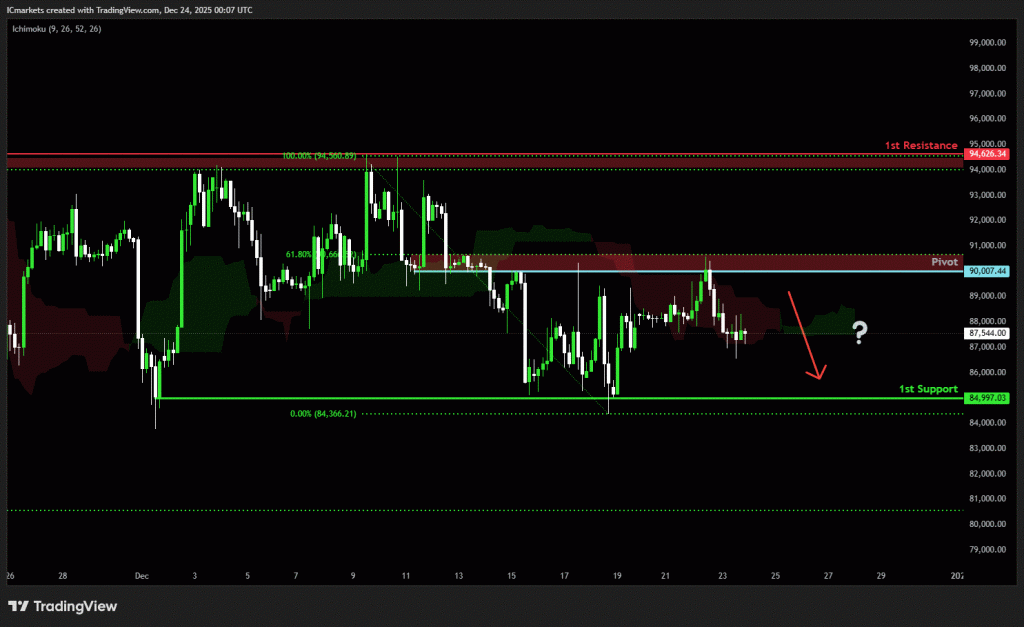
GBP/USD:
Potential Direction: Bullish
Overall momentum of the chart: Bullish
The price could see a short-term pullback toward the pivot before rising again toward the 1st resistance.
Pivot: 1.3435
Supporting reasons: Identified as a pullback support, where renewed buying pressure could emerge to push the price higher.
1st support: 1.3366
Supporting reasons: Identified as a pullback support, indicating a potential area where the price could stabilize once more.
1st resistance: 1.3530
Supporting reasons: Identified as a swing high resistance, indicating a potential level that could halt further upward movement.
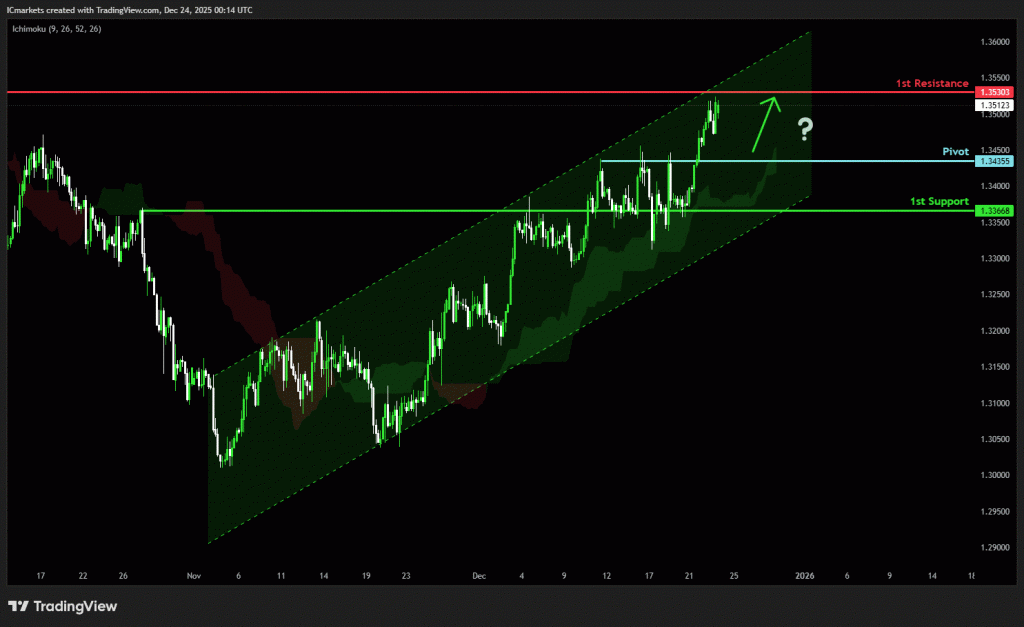
GBP/JPY:
Potential Direction: Bullish
Overall momentum of the chart: Bullish
The price could see a short-term pullback toward the pivot before rising again toward the 1st resistance.
Pivot: 208.94
Supporting reasons: Identified as a pullback resistance, where selling pressures could intensify and potentially cap any upward retracement
1st support: 207.17
Supporting reasons: Identified as an overlap support, indicating a potential level where the price could stabilize once more.
1st resistance: 211.47
Supporting reasons: Identified as a swing high resistance, indicating a potential level that could halt further upward movement.
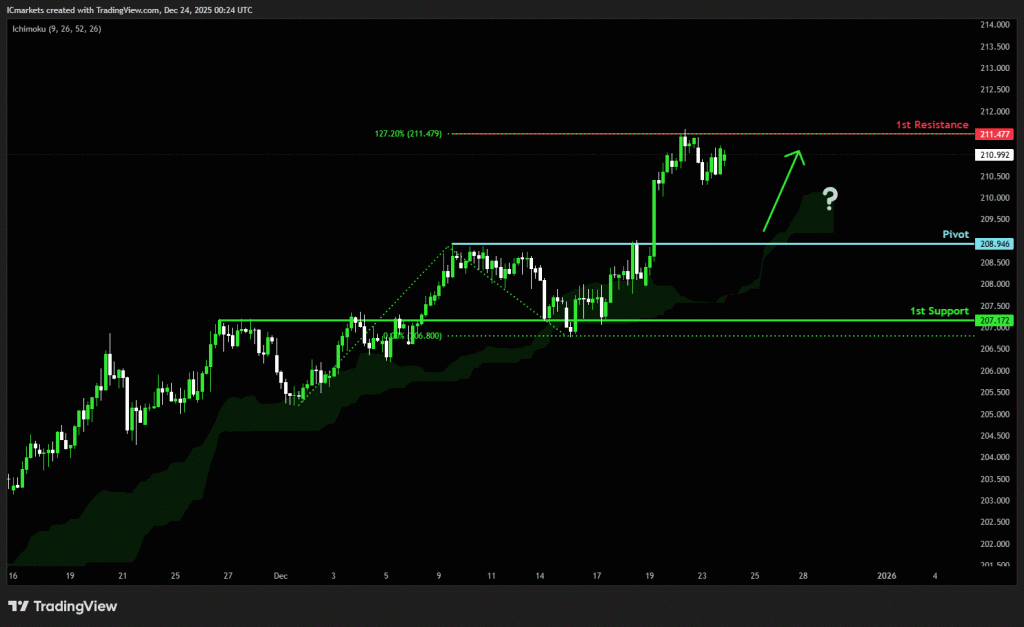
USD/CHF:
Potential Direction: Bearish
Overall momentum of the chart: Bearish
The price could see a short-term pullback toward the pivot before continuing its bearish move down toward the 1st support.
Pivot: 0.7932
Supporting reasons: Identified as a pullback resistance, where selling pressures could intensify and potentially cap any upward retracement.
1st support: 0.7872
Supporting reasons: Identified as a swing low support, indicating a potential level where the price could stabilize once again.
1st resistance: 0.7989
Supporting reasons: Identified as an overlap resistance, indicating a potential level that could cap further upward movement.

USD/JPY:
Potential Direction: Bullish
Overall momentum of the chart: Bullish
The price could see a short-term pullback toward the pivot before rising again toward the 1st resistance.
Pivot: 155.96
Supporting reasons: Identified as a pullback support that aligns with the 50% Fibonacci retracement, where renewed buying pressure could emerge to push the price higher.
1st support: 154.44
Supporting reasons: Identified as an overlap support, indicating a strong area where buyers might return, and the price could stabilize once again.
1st resistance: 157.58
Supporting reasons: Identified as a swing high resistance. This level represents the next key area where upward movement could be capped amid increased selling pressure
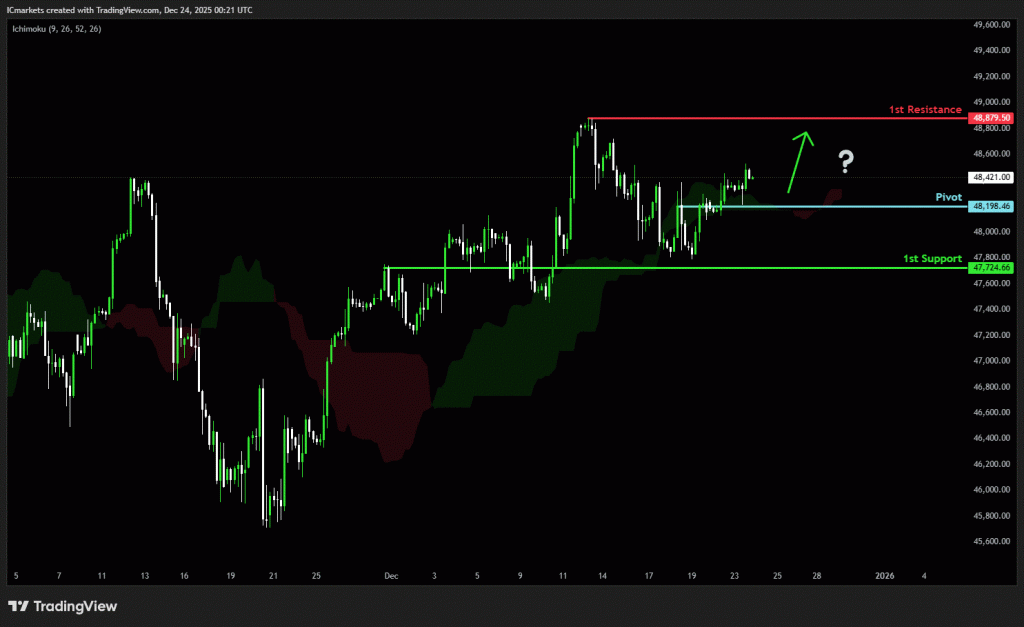
USD/CAD:
Potential Direction: Bearish
Overall momentum of the chart: Bearish
The price could see a short-term pullback toward the pivot before continuing its bearish move down toward the 1st support.
Pivot: 1.3737
Supporting reasons: Identified as a pullback resistance, where selling pressures could intensify and potentially cap any upward retracement.
1st support: 1.3684
Supporting reasons: Identified as a support that is supported by the 161.8% Fibonacci extension, indicating a key level where the price could stabilize once more.
1st resistance: 1.3889
Supporting reasons: Identified as a pullback resistance, making it a possible target for bullish advances and a level where some sellers could return to cap gains
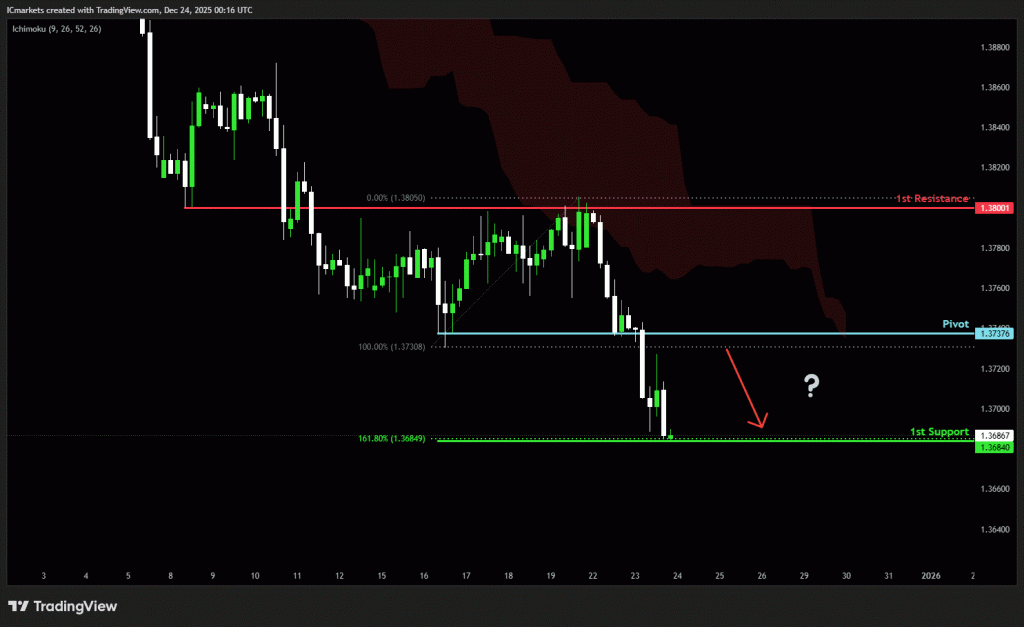
AUD/USD:
Potential Direction: Bullish
Overall momentum of the chart: Bullish
The price could see a short-term pullback toward the pivot before rising again toward the 1st resistance.
Pivot: 0.6674
Supporting reasons: Identified as a pullback support, where renewed buying pressure could emerge to push the price higher..
1st support: 0.6611
Supporting reasons: Identified as a pullback support, this area has provided strong support historically and may attract buying interest for a potential short-term bounce
1st resistance: 0.6742
Supporting reasons: Identified as a resistance is supported by the 161.8% Fibonacci extension, indicating a potential area that could halt any further upward movement.
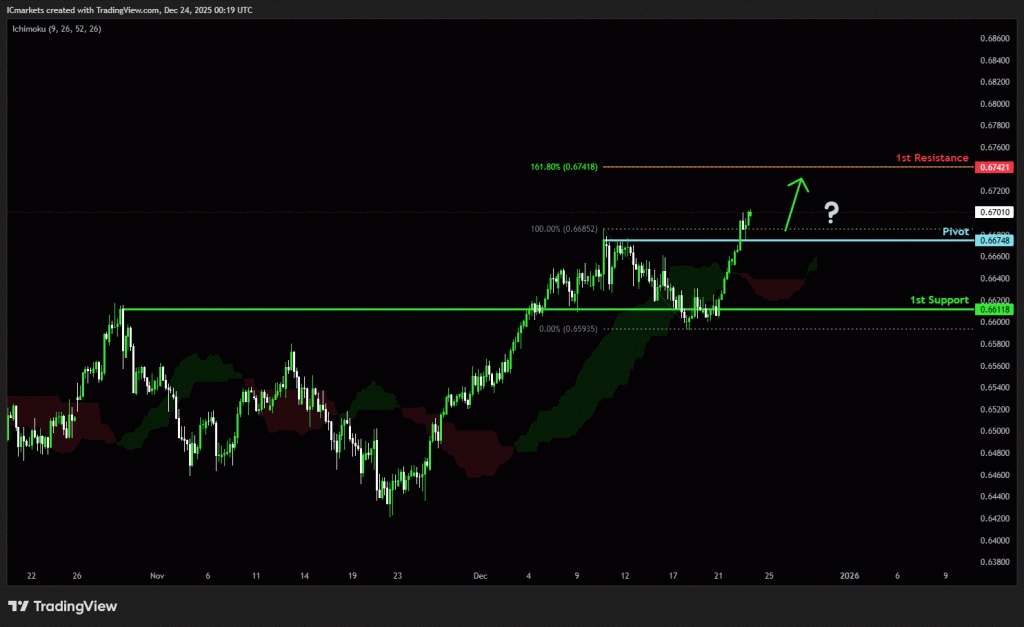
NZD/USD
Potential Direction: Bullish
Overall momentum of the chart: Bullish
The price could see a short-term pullback toward the pivot before rising again toward the 1st resistance.
Pivot: 0.5793
Supporting reasons: Identified as a pullback support, where renewed buying pressure could emerge to push the price higher.
1st support: 0.5744
Supporting reasons: Identified as an overlap support, this area has provided strong support historically and may attract buying interest for a potential short-term bounce
1st resistance: 0.5889
Supporting reasons: Identified as a resistance is supported by the 161.8% Fibonacci extension, indicating a potential area that could halt any further upward movement.
US30 (DJIA):
Potential Direction: Bullish
Overall momentum of the chart: Bullish
The price has already bounced off the pivot and may continue its bullish move toward the 1st resistance
Pivot: 48,198.46
Supporting reasons: Identified as an overlap support, where renewed buying pressure could emerge to push the price higher.
1st support: 47,724.66
Supporting reasons: Identified as a pullback support, suggesting a potential area where the price could stabilize once again.
1st resistance: 48,879.50
Supporting reasons: Identified as a swing high resistance, indicating a potential area that could halt any further upward movement.

DE40 (DAX):
Potential Direction: Bullish
Overall momentum of the chart: Bullish
The price could see a short-term pullback toward the pivot before rising again toward the 1st resistance.
Pivot: 24,108
Supporting reasons: Identified as a pullback support, where renewed buying pressure could emerge to push the price higher.
1st support: 23,860.89
Supporting reasons: Identified as an overlap support, indicating a key level where the price could stabilize once more.
1st resistance: 24,511.92
Supporting reasons: Identified as a swing high resistance, indicating a potential area that could halt any further upward movement.
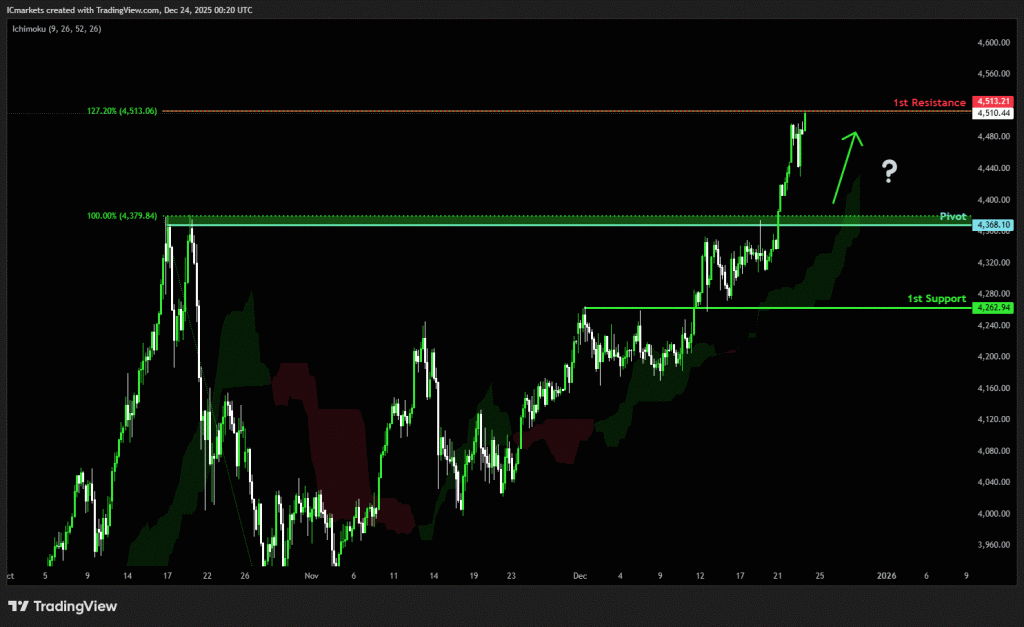
US500 (S&P 500):
Potential Direction: Bullish
Overall momentum of the chart: Bullish
The price could see a short-term pullback toward the pivot before rising again toward the 1st resistance.
Pivot: 6,828.80
Supporting reasons: Identified as a pullback support, where renewed buying pressure could emerge to push the price higher.
1st support: 6,714.05
Supporting reasons: Identified as an overlap support, indicating a potential level where the price could stabilize once again.
1st resistance: 6,923.08
Supporting reasons: Identified as a swing low resistance, indicating a potential area that could halt any further upward movement.

BTC/USD (Bitcoin):
Potential Direction: Bearish
Overall momentum of the chart: Bearish
The price has already reacted off the pivot and may continue its bearish move toward the 1st support.
Pivot: 90.007.44
Supporting reasons: Identified as an overlap resistance that aligns with the 61.8% Fibonacci retracement, where selling pressures could intensify and potentially cap any upward retracement.
1st support: 84,997.03
Supporting reasons: Identified as a swing low support, indicating a potential level where the price could stabilize once more.
1st resistance: 94,626.23
Supporting reasons: Identified as an overlap resistance that aligns with the 50% Fibonacci retracement, indicating a potential area that could halt any further upward movement.

ETH/USD (Ethereum):
Potential Direction: Bearish
Overall momentum of the chart: Bullish
The price has already reacted off the pivot and may continue its bearish move toward the 1st support.
Pivot: 3,074.77
Supporting reasons: Identified as an overlap resistance, where selling pressures could intensify and potentially cap any upward retracement.
1st support: 2,740.05
Supporting reasons: Identified as a swing low support, indicating a potential level where the price could stabilize once more.
1st resistance: 3,206.26
Supporting reasons: Identified as a pullback resistance, indicating a potential area that could halt any further upward movement.
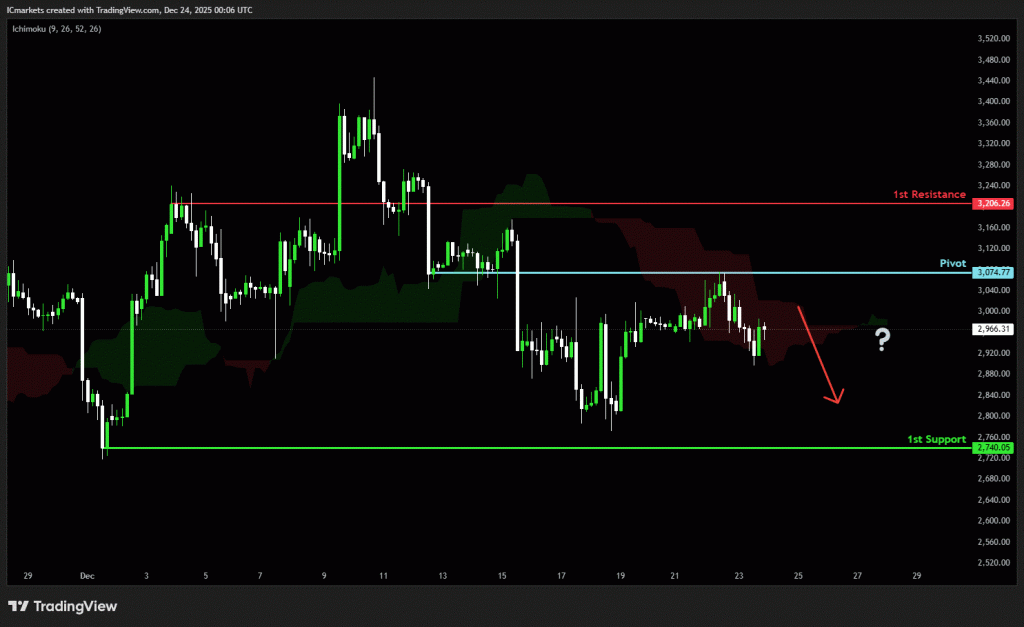
WTI/USD (Oil):
Potential Direction: Bullish
Overall momentum of the chart: Bullish
The price could see a short-term pullback toward the pivot before rising again toward the 1st resistance.
Pivot: 57.73
Supporting reasons: Identified as a pullback support, where renewed buying pressure could emerge to push the price higher.
1st support: 56.87
Supporting reasons: Identified as a pullback support, indicating a key level where the price could stabilize once more.
1st resistance: 60.27
Supporting reasons: Identified as a swing high resistance, indicating a potential area that could halt any further upward movement.
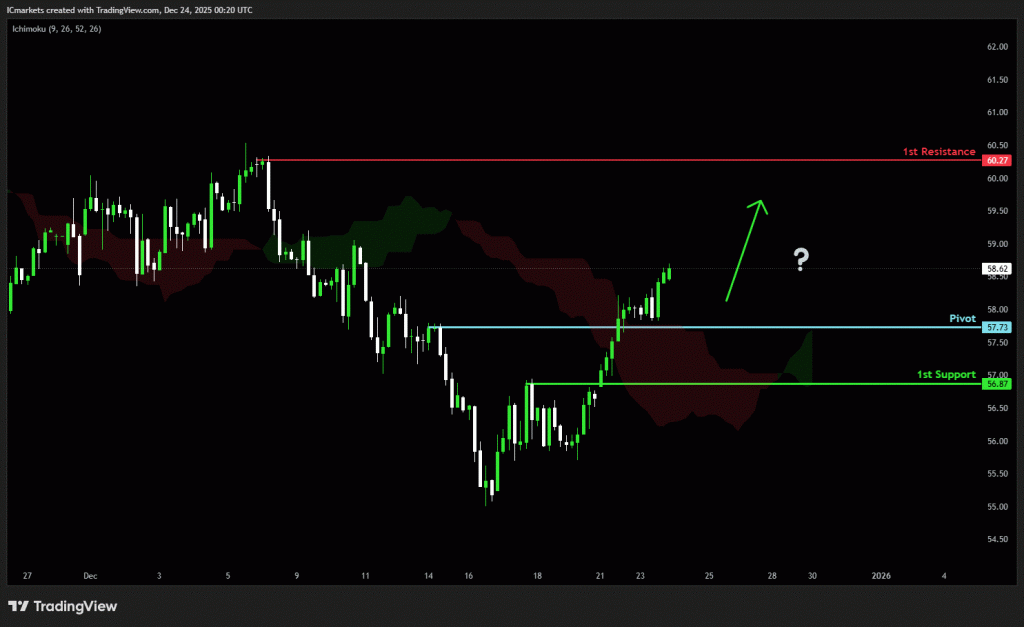
XAU/USD (GOLD):
Potential Direction: Bullish
Overall momentum of the chart: Bullish
The price could see a short-term pullback toward the pivot before rising again toward the 1st resistance.
Pivot: 4,368.10
Supporting reasons: Identified as a pullback support, where renewed buying pressure could emerge to push the price higher.
1st support: 4,262.94
Supporting reasons: Identified as a pullback support, indicating a key level where the price could stabilize once more.
1st resistance: 4,513.21
Supporting reasons: Identified as a resistance that aligns with the 127.2% Fibonacci extension, indicating a potential area that could halt any further upward movement.

The accuracy, completeness and timeliness of the information contained on this site cannot be guaranteed. IC Markets Global does not warranty, guarantee or make any representations, or assume any liability regarding financial results based on the use of the information in the site.
News, views, opinions, recommendations and other information obtained from sources outside of www.icmarkets.com, used in this site are believed to be reliable, but we cannot guarantee their accuracy or completeness. All such information is subject to change at any time without notice. IC Markets Global assumes no responsibility for the content of any linked site.
The fact that such links may exist does not indicate approval or endorsement of any material contained on any linked site. IC Markets Global is not liable for any harm caused by the transmission, through accessing the services or information on this site, of a computer virus, or other computer code or programming device that might be used to access, delete, damage, disable, disrupt or otherwise impede in any manner, the operation of the site or of any user’s software, hardware, data or property.
The post Wednesday 24th December 2025: Technical Outlook and Review first appeared on IC Markets | Official Blog.
Ex-Dividend 24/12/2025
424790 December 23, 2025 17:39 ICMarkets Market News
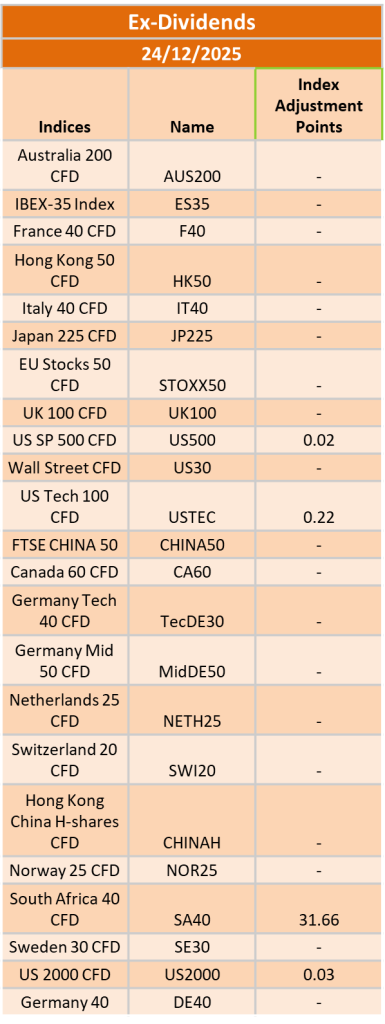
The post Ex-Dividend 24/12/2025 first appeared on IC Markets | Official Blog.
IC Markets Global – Asia Fundamental Forecast | 23 December 2025
424787 December 23, 2025 15:00 ICMarkets Market News
IC Markets Global – Asia Fundamental Forecast | 23 December 2025
What happened in the U.S. session?
Over the latest U.S. session, markets digested a relatively light but still meaningful macro docket centered on durable goods data, updated GDP figures, and consumer sentiment, alongside incremental headlines around year‑end Fed policy expectations and equity rotation. Durable goods orders surprised to the upside versus consensus, while revisions to quarterly GDP remained consistent with a solid but not overheating growth backdrop, and consumer confidence hovered near prior levels, reinforcing the narrative of a moderating yet resilient U.S. economy into year‑end.
What does it mean for the Asia Session?
Asian traders face a dense macro slate in a thin, year‑end market, led by the final US Q3 GDP estimate, October durable goods orders, and December Conference Board consumer confidence, all of which will reset expectations for the Fed’s 2026 easing path and drive USD, rates, and equity futures into the Asia evening. Canada’s October GDP and the Bank of Canada’s deliberations, together with final November machine tool orders from Japan, add further cues on global growth and manufacturing, feeding into risk sentiment for export‑heavy Asian markets.
The Dollar Index (DXY)
Key news events today
ADP Weekly Employment Change (Tentative)
Prelim GDP q/q (1L30 pm GMT)
Core Durable Goods Orders m/m (1:30 pm GMT)
Durable Goods Orders m/m (1:30 pm GMT)
Prelim GDP Price Index q/q (1:30 pm GMT)
CB Consumer Confidence (3:00 pm GMT)
Richmond Manufacturing Index (3:00 pm GMT)
What can we expect from DXY today?
The Dollar is trading weaker overall, extending its December slide as markets continue to price in easier Federal Reserve policy and digest softer U.S. inflation data, while pre‑holiday liquidity keeps intraday ranges relatively contained. The U.S. Dollar Index (DXY) is hovering in the high‑98 area after falling sharply following the Fed’s mid‑December rate cut, leaving it around 9% lower year‑to‑date and near the bottom of its 12‑month range.
Central Bank Notes:
- The Federal Open Market Committee (FOMC) is widely expected to lower the federal funds rate target range by 25 basis points to 3.50%–3.75% at its December 9–10, 2025, meeting, marking the third consecutive cut after the October reduction to 3.75%–4.00%
- The Committee continues to pursue maximum employment and 2% inflation goals, with the labor market showing further softening as the unemployment rate rose to 4.4% in September 2025 amid modest job gains.
- Officials note persistent downside risks to growth alongside resilient activity, with inflation easing to 3.0% year-over-year CPI in September but remaining elevated due to tariff effects; core PCE stands at around 2.8% as of October.
- Economic activity grew at a 3.8% annualized pace in Q2 2025 per revised estimates, though Q3 and Q4 face headwinds from trade tensions, fiscal restraint, and data disruptions like the government shutdown.
- September’s Summary of Economic Projections forecasts 2025 unemployment at a median of 4.5%, with PCE inflation near 3.0% and core PCE at 3.1%, signaling a gradual disinflation path. Updates expected on December 10 may adjust for higher unemployment and lower growth.
- The Committee maintained its data-dependent approach, noting a softening labor market and inflation above the 2% target, while deciding to lower the federal funds rate target range by 25 basis points to 3.50%-3.75%. Dissent persisted, with multiple members opposing the cut or advocating for a hold, reflecting divisions similar to recent meetings.
- The FOMC confirmed the conclusion of its quantitative tightening program effective December 1, 2025, with Treasury rolloff caps at $5 billion per month and agency MBS caps at $35 billion per month to ensure ample reserves and market stability.
- The next meeting is scheduled for 27 to 28 January 2026.
Next 24 Hours Bias
Medium Bearish
Gold (XAU)
Key news events today
ADP Weekly Employment Change (Tentative)
Prelim GDP q/q (1L30 pm GMT)
Core Durable Goods Orders m/m (1:30 pm GMT)
Durable Goods Orders m/m (1:30 pm GMT)
Prelim GDP Price Index q/q (1:30 pm GMT)
CB Consumer Confidence (3:00 pm GMT)
Richmond Manufacturing Index (3:00 pm GMT)
What can we expect from Gold today?
Gold is trading near fresh record highs above the 4,400 USD/oz area going into Tuesday, with momentum still bullish but increasingly stretched after a powerful December impulse rally. The move is being driven by expectations of easier Federal Reserve policy, heavy central‑bank and safe‑haven demand, and ongoing geopolitical tensions, which have helped push year‑to‑date gains to roughly 70% and keep spot prices sitting well above key moving averages and prior cycle highs.
Next 24 Hours Bias
Medium Bullish
The Australian Dollar (AUD)
Key news events today
No major news event
What can we expect from AUD today?
The Australian Dollar (AUD) has shown resilience amid mixed global cues, trading around 0.6620-0.6640 against the USD as of late December 22, 2025 (noting the query date of December 23 aligns with Australian time zones ahead of PST), buoyed by elevated consumer inflation expectations at 4.7% that fuel speculation of a Reserve Bank of Australia (RBA) rate hike. Traders anticipate the RBA’s December 9 policy meeting minutes due Tuesday, December 23, which held the cash rate at 3.6% and could clarify hawkish leanings amid persistent inflation pressures, potentially supporting further AUD gains if dovish US Fed expectations weaken the USD.
Central Bank Notes:
- The Reserve Bank of Australia held its cash rate steady at 3.60% at the November 2025 policy meeting, adopting a cautious tone amid a surprise uptick in inflation data for the September quarter. This marks the fourth consecutive pause since the 25 basis point cut in August. The Board attributed some of the inflation rise to temporary factors like higher petrol prices and council rates, but noted signs of more persistent pressures from consumer demand.
- Policymakers emphasized vigilance on inflation, with trimmed mean inflation expected to remain elevated in the near term before nearing the 2–3% target midpoint by mid-2027. Recent data showed underlying inflation staying above target until at least the second half of 2026, prompting upward revisions to forecasts. Capacity pressures are seen as slightly more pronounced than previously assessed, delaying any easing.
- Headline CPI for the September quarter exceeded expectations, driven partly by temporary items, while underlying measures signal ongoing stickiness. The shift to monthly CPI reporting, with the first full edition in November 2025, will enhance real-time inflation monitoring. Housing and services remain resilient contributors to price pressures.
- Domestic demand shows firmness in services alongside below-trend growth elsewhere, with capacity pressures not expected to ease significantly. The labor market is gradually softening, with unemployment projected to stabilize around 4.4%, though wage growth and productivity dynamics keep unit labor costs a concern. Household spending faces headwinds from high borrowing costs.
- Global risks include geopolitical tensions and commodity volatility, set against modestly revised-up world growth outlooks. The Board describes its policy as mildly restrictive and data-dependent, balancing inflation control with employment goals. No rate hike was considered despite the inflation surprise.
- Monetary policy remains mildly restrictive to address lingering price stability risks amid household and global vulnerabilities. Communications reaffirm the dual mandate of 2–3% inflation and full employment, with readiness to adjust based on incoming data.
- Market expectations point to the cash rate holding through early 2026, with a possible modest cut to 3.3% mid-year if inflation eases as forecast. The new monthly CPI data will be key for timely insights.
- Monetary policy remains mildly restrictive, balancing progress on price stability against vulnerabilities in household demand and global outlook. Board communications reaffirm a dual mandate: price stability and full employment, while underscoring readiness to respond should risks materialize sharply.
- Analysts generally expect the cash rate to remain at current levels through early 2026, with only modest cuts possible later in the year if inflation moderates. The new monthly CPI release (first full edition Nov 2025) will be watched closely for timely signals on price trends.
- The next meeting is on 2 to 3 February 2026.
Next 24 Hours Bias
Medium Bullish
The Kiwi Dollar (NZD)
Key news events today
No major news event
What can we expect from NZD today?
The New Zealand dollar is trading modestly firmer against the US dollar around the mid‑0.57 area, extending a gradual recovery seen over the past month as markets digest improving domestic growth data and a steady policy outlook from the Reserve Bank of New Zealand (RBNZ). Sentiment toward the Kiwi is being underpinned by confirmation that New Zealand’s economy returned to growth in Q3, which has helped the currency gain roughly 2.8% over the last month against the USD.
Central Bank Notes:
- The Monetary Policy Committee (MPC) left the Official Cash Rate (OCR) unchanged at 2.25% at its 26 November 2025 meeting, following the widely anticipated 25-basis-point reduction from 2.50%, and signaled that policy is now firmly in stimulatory territory while keeping the option of further easing on the table if needed.
- The decision was again reached by consensus, with members judging that the cumulative 325 basis points of easing over the past year warranted a period of assessment, even as several emphasized a willingness to cut further should incoming data point to a more protracted downturn or renewed disinflationary pressures.
- Headline consumer price inflation is projected to hover near 3% in late 2025 before gradually easing toward the 2% midpoint of the 1–3% target band through 2026, supported by contained inflation expectations around 2.3% over the two-year horizon and an expected pickup in spare capacity.
- The MPC noted that domestic demand remains subdued but shows tentative signs of stabilisation, with softer household spending and construction only partially offset by improving services activity; nevertheless, policymakers still expect services inflation to ease as wage growth moderates and the labour market loosens further over the coming year.
- Financial conditions continue to ease as wholesale and retail borrowing rates reprice to the lower OCR, contributing to gradually rising mortgage approvals and improving housing-related sentiment, although broader business credit growth remains patchy and sensitive to uncertainty about the durability of the recovery.
- Recent data confirm that GDP momentum is weak but not deteriorating as sharply as earlier in 2025, with high-frequency indicators pointing to a shallow recovery from a low base and ongoing headwinds from elevated living costs and fragile confidence weighing on discretionary consumption and investment.
- The MPC reiterated that external risks remain skewed to the downside, particularly from softer Chinese demand and uncertainty around United States trade policy, but noted that a lower New Zealand dollar continues to provide some offset via improved export competitiveness and support for tradables inflation.
- Looking ahead to early 2026, the Committee maintained a mild easing bias, indicating that a further cut toward 2.00–2.10% cannot be ruled out if activity fails to gain traction or if inflation undershoots projections, but current forecasts envisage the OCR remaining near 2.25% for an extended period provided inflation converges toward target and the recovery proceeds broadly as expected.
- The next meeting is on 18 February 2026.
Next 24 Hours Bias
Medium Bullish
The Japanese Yen (JPY)
Key news events today
No major news event
What can we expect from JPY today?
The Japanese yen is trading slightly stronger at the start of the week as verbal intervention from Japanese authorities and safe‑haven demand partially offset recent post‑BoJ selling, with USD/JPY pulling back from the 158 area toward the mid‑156s. After the Bank of Japan’s December meeting, where it raised its policy rate to 0.75% the highest in about 30 years, but signalled only gradual further tightening, markets continued to sell the yen and pushed USD/JPY above 158, treating the hike as largely priced in and remaining focused on still‑wide yield differentials with the US.
Central Bank Notes:
- The Policy Board of the Bank of Japan will meet on 18–19 December with markets almost fully pricing a 25-basis-point hike, which would raise the short-term policy rate from 0.50% to around 0.75%, as the bank moves further away from its ultra-loose stance while stressing that any tightening will remain gradual and data-dependent.
- The BOJ is expected to continue guiding the uncollateralized overnight call rate in a narrow band around the new policy rate, near 0.75%, while signaling that the pace and timing of any additional hikes will depend on how past increases affect bank lending, corporate financing conditions, and overall economic activity.
- The quarterly path of JGB purchases remains on a pre-announced, gradual taper: outright purchases are being reduced by about ¥400 billion per quarter through March 2026, then by roughly ¥200 billion per quarter from April to June 2026, with the bank still aiming for JGB purchases to settle near ¥2 trillion in Q1 2027 and retaining flexibility to adjust the pace if market functioning or yield volatility deteriorate.
- Japan’s economy has softened in the near term, with Q3 2025 GDP contracting at an annualized pace of about 2.3% as weaker residential investment and external demand weighed on activity, even as business sentiment in manufacturing has recently improved to a roughly four-year high.
- Core consumer inflation (excluding fresh food) accelerated to around 3.0% year-on-year in October, up from 2.9% in September and remaining above the BOJ’s 2% target, while the “core-core” measure excluding both fresh food and energy rose to about 3.1%, underscoring persistent underlying price pressures.
- In the very near term, some input-cost pressures are easing as earlier import price surges fade, but services inflation linked to labor shortages, along with steady wage gains, continues to support broader price momentum; firms’ and households’ medium-term inflation expectations remain anchored slightly above 2%, keeping short-term inflation risks tilted to the upside.
- For the coming quarters, the BOJ assesses that real growth will likely run below potential as the economy digests tighter financial conditions and past yen depreciation, though accommodative real rates, positive real wage growth, and improving corporate sentiment should help sustain a modest recovery in private consumption and business investment.
- Over the medium term, as overseas demand stabilizes and domestic labor markets remain tight, the BOJ expects wage settlements and inflation expectations to keep core inflation on a gradual upward trajectory around or slightly above 2%, providing room for further cautious rate normalization as long as financial conditions remain supportive and the recovery is not derailed.
- The next meeting is scheduled for 22 to 23 January 2026.
Next 24 Hours Bias
Strong Bearish
Oil
Key news events today
API Crude Oil Stock (8:30 pm GMT)
What can we expect from Oil today?
Oil is rebounding after a sharp slide this year, with CFD benchmarks showing WTI near 57–58 USD/bbl and Brent around 61–62 USD/bbl, still roughly 16–18% lower than the same time in 2024 as surplus supply and a “cartoonishly oversupplied” market cap rally. The latest move up is driven by the U.S. interception of a Venezuela‑linked tanker and ongoing Russia–Ukraine war risks, which have pushed Brent to about 61.8 USD and WTI to roughly 57.8 USD on Monday, raising concern about possible supply disruptions.
Next 24 Hours Bias
Medium Bearish
The post IC Markets Global – Asia Fundamental Forecast | 23 December 2025 first appeared on IC Markets | Official Blog.
IC Markets Global – Europe Fundamental Forecast | 23 December 2025
424786 December 23, 2025 15:00 ICMarkets Market News
IC Markets Global – Europe Fundamental Forecast | 23 December 2025
What happened in the Asia session?
Asian markets session traded positively amid year-end rally hopes, extending gains from Wall Street and Japan’s recent rate hike to 0.75%, though no major macro data releases emerged to drive volatility. Equities like Nikkei, ASX 200, and Hang Seng led advances, boosted by tech plays and foreign flows, while USD/JPY benefited from yen weakness and commodities such as gold hit fresh highs in low-volume holiday conditions. Overall, sentiment favoured the continuation of global bullishness without disruptive headlines
What does it mean for the Europe & US sessions?
Today features critical U.S. GDP, durable goods, and consumer confidence data at key times (13:30 and 22:00 GMT), likely dominating both European and U.S. sessions amid thin holiday trading and gold’s safe-haven surge, while Europe lacks major releases. Watch for cross-market ripples and the early Wednesday close. U.S. stock futures (Dow, S&P 500, Nasdaq) held steady overnight, eyeing records despite pending data gaps. Australia’s ASX is poised for gains on U.S. tech strength, with Elders reporting strong FY results.
The Dollar Index (DXY)
Key news events today
ADP Weekly Employment Change (Tentative)
Prelim GDP q/q (1L30 pm GMT)
Core Durable Goods Orders m/m (1:30 pm GMT)
Durable Goods Orders m/m (1:30 pm GMT)
Prelim GDP Price Index q/q (1:30 pm GMT)
CB Consumer Confidence (3:00 pm GMT)
Richmond Manufacturing Index (3:00 pm GMT)
What can we expect from DXY today?
The dollar remains under mild selling pressure from Fed dovishness and thin holiday volumes, with the index near 98.30 and gains in the euro and other peers, though no major catalysts emerged today amid focus on year-end flows. Recent Fed rate cuts and signals of further easing have pressured the dollar, alongside profit-taking in pairs like AUD/USD, which retreated amid US strength and risk aversion.
Central Bank Notes:
- The Federal Open Market Committee (FOMC) is widely expected to lower the federal funds rate target range by 25 basis points to 3.50%–3.75% at its December 9–10, 2025, meeting, marking the third consecutive cut after the October reduction to 3.75%–4.00%
- The Committee continues to pursue maximum employment and 2% inflation goals, with the labour market showing further softening as the unemployment rate rose to 4.4% in September 2025 amid modest job gains.
- Officials note persistent downside risks to growth alongside resilient activity, with inflation easing to 3.0% year-over-year CPI in September but remaining elevated due to tariff effects; core PCE stands at around 2.8% as of October.
- Economic activity grew at a 3.8% annualised pace in Q2 2025 per revised estimates, though Q3 and Q4 face headwinds from trade tensions, fiscal restraint, and data disruptions like the government shutdown.
- September’s Summary of Economic Projections forecasts 2025 unemployment at a median 4.5%, with PCE inflation near 3.0% and core PCE at 3.1%, signalling a gradual disinflation path; updates expected on December 10 may adjust for higher unemployment and lower growth.
- The Committee maintained its data-dependent approach, noting a softening labour market and inflation above the 2% target, while deciding to lower the federal funds rate target range by 25 basis points to 3.50%-3.75%. Dissent persisted, with multiple members opposing the cut or advocating for a hold, reflecting divisions similar to recent meetings.
- The FOMC confirmed the conclusion of its quantitative tightening program effective December 1, 2025, with Treasury rolloff caps at $5 billion per month and agency MBS caps at $35 billion per month to ensure ample reserves and market stability.
- The next meeting is scheduled for 27 to 28 January 2026.
Next 24 Hours Bias
Medium Bearish
Gold (XAU)
Key news events today
ADP Weekly Employment Change (Tentative)
Prelim GDP q/q (1L30 pm GMT)
Core Durable Goods Orders m/m (1:30 pm GMT)
Durable Goods Orders m/m (1:30 pm GMT)
Prelim GDP Price Index q/q (1:30 pm GMT)
CB Consumer Confidence (3:00 pm GMT)
Richmond Manufacturing Index (3:00 pm GMT)
What can we expect from Gold today?
Gold prices reached new all-time highs around $4,443 per ounce, surging over 2% amid heightened geopolitical tensions and expectations of US Federal Reserve rate cuts in 2026. The precious metal has risen about 70% year-to-date, outperforming stocks like the S&P 500, driven by safe-haven demand from events such as President Trump’s blockade on Venezuelan oil tankers and softer US economic data like jobs and inflation figures.
Next 24 Hours Bias
Strong Bullish
The Euro (EUR)
Key news events today
No major news event
What can we expect from EUR today?
The Euro (EUR) is showing modest strength against the US Dollar on December 23, 2025, trading near 1.1750 amid USD weakness ahead of key US GDP data releases. Recent ECB projections indicate a slightly depreciated euro outlook, with assumptions of EUR/USD at around 1.13 in 2025 and 1.16 in subsequent years, influenced by competitiveness challenges and revised interest rate expectations.
Central Bank Notes:
- The Governing Council of the ECB is widely expected to keep the three key interest rates unchanged at its 17–18 December 2025 meeting, maintaining the main refinancing rate at 2.15%, the marginal lending facility at 2.40% and the deposit facility at 2.00%. This would reflect policymakers’ assessment that the current policy stance remains broadly consistent with medium‑term price stability, while inflation hovers close to the 2% target and the economy expands at a modest pace. Market pricing and recent ECB commentary suggest a high “option value” in staying on hold, with no clear pre‑set path for the next move amid two‑sided risks around growth and inflation.
- Recent indicators point to broadly stable price dynamics around the ECB’s target. Headline HICP inflation is projected to hover near 2% through late 2025, with earlier energy‑related disinflation largely behind and food price pressures contained compared with previous years. Services and wage inflation remain somewhat firmer than anticipated, but the trend is one of gradual moderation, consistent with a scenario in which inflation stabilizes around but not persistently above 2% over the medium term.
- Eurosystem staff projections to be released in December are expected to show only small revisions from the September exercise, maintaining a profile of headline inflation close to 2% in 2025, dipping slightly below in 2026, and returning near target in 2027. Soft producer prices, fading pipeline cost pressures, and anchored long‑term inflation expectations limit upside risks, though officials continue to flag uncertainty from geopolitical tensions, commodity price shocks, and fiscal policy choices.
- Euro area GDP growth remains subdued but resilient, with most forecasters and survey‑based indicators pointing to an expansion around 1 — 1.25% in 2025 and 2026, followed by a similar pace into 2027. PMIs and confidence surveys suggest activity has stabilised after earlier weakness, with modest support from public investment and improving external demand offsetting soft private consumption and investment.
- The labour market remains tight in aggregate, with unemployment rates close to multi‑decade lows and participation relatively high, even as job creation has slowed from its earlier peak. Real income growth has turned slightly positive again as inflation normalises, underpinning household spending, while financing conditions, though tighter than in the pre‑hiking era, remain consistent with a gradual expansion in credit to households and firms.
- Business sentiment is mixed, reflecting uncertainty around global trade, the policy outlook in the United States, and the potential impact of future tariff or industrial policy shifts. At the same time, easing supply‑chain costs and a relatively competitive euro exchange rate versus major trading partners provide support to manufacturing and export‑oriented sectors at the margin.
- The Governing Council is expected to reiterate that future decisions will remain data-dependent and taken meeting by meeting, based on an integrated assessment of the inflation outlook, the dynamics of underlying inflation, and the strength of monetary policy transmission. Officials have recently stressed that both further hikes and eventual cuts remain contingent on incoming data, implying no commitment to a particular path and a readiness to adjust if inflation or growth diverge materially from baseline projections.
- Balance sheet normalisation is set to continue gradually and predictably, with the stock of assets under the APP and PEPP declining as reinvestments have already been halted or scaled back in line with prior guidance. The ECB is expected to confirm that the current pace of portfolio runoff remains appropriate, supporting a slow withdrawal of monetary accommodation without disrupting market functioning.
- The next meeting is on 4 to 5 January 2026
Next 24 Hours Bias
Medium Bullish
The Swiss Franc (CHF)
Key news events today
No major news event
What can we expect from CHF today?
The Swiss Franc (CHF) shows limited specific news amid holiday-thinned trading, but recent trends indicate ongoing strength against the USD and EUR, influenced by the Swiss National Bank’s steady policy stance. As of mid-December data, the USD/CHF exchange rate stood at around 0.795 (or inversely 1.256 USD per CHF), reflecting a slight daily dip but an 11.55% yearly gain for the franc.
Central Bank Notes:
- At its 11 December 2025 monetary policy assessment, the Swiss National Bank (SNB) is widely expected to leave the policy rate unchanged at 0%, extending the pause that began in September as the Governing Board judges that current settings are sufficient to keep inflation near, but still below, its target while avoiding an unnecessary move into negative rates.
- Recent data show that the tentative rebound in Swiss inflation has stalled, with headline CPI easing from 0.1% year‑on‑year in October to 0.0% in November and core inflation slipping to about 0.4%, reinforcing the view that underlying price pressures remain very weak and that deflation risks, while contained, have not fully disappeared.
- The SNB’s conditional inflation forecast is likely to remain close to the September projections, with inflation still seen averaging roughly 0.2% in 2025, 0.5% in 2026, and 0.7% in 2027 under an unchanged policy rate path, though the latest CPI prints argue for a slightly lower near‑term profile and keep open the option of renewed easing if activity or prices weaken further.
- The global backdrop has deteriorated further, as continuing U.S. tariff actions and softer external demand weigh on world trade, while uncertainty in key European and U.S. markets for Swiss exports persists, leaving the SNB cautious about the growth outlook despite Switzerland’s relatively resilient domestic demand.
- Business and labour-market sentiment in export‑oriented manufacturing remains subdued, with firms reporting pressure on margins from the still‑strong franc and softer foreign orders, although the broader economy is still expected to grow at around 1–1.5% in 2025 and unemployment only drifting up gradually from low levels.
- The SNB continues to stress its willingness to act if deflation risks re‑emerge, reiterating that it can ease policy through renewed rate cuts or targeted foreign‑exchange intervention if necessary, while also highlighting its commitment to transparent communication, including the publication of detailed minutes from recent assessments and ongoing dialogue with international partners on FX policy
The next meeting is on 19 March 2026.
Next 24 Hours Bias
Medium Bullish
The Pound (GBP)
Key news events today
No major news event
What can we expect from GBP today?
The Pound held firm around 1.345-1.346 versus the USD in quiet holiday trading, extending gains from December 22’s 0.63% rally fueled by the Bank of England’s cautious stance on rate cuts and a softer Dollar, with year-to-date strength at 7.58% underscoring broader optimism despite looming BoE easing risks.
Central Bank Notes:
- The Bank of England’s Monetary Policy Committee (MPC) will meet on 18 December 2025, with the current Bank Rate standing at 4.00 per cent after being held in a close 5–4 vote at the 5 November meeting. Market pricing and analyst commentary point to a high risk of a 25‑basis‑point cut to 3.75 per cent, but this remains conditional on incoming inflation and labour‑market data, so the December note should be treated as pre‑decision guidance rather than an ex‑post summary.
- The BoE is expected to leave its quantitative tightening (QT) framework broadly unchanged through year‑end, maintaining the lower reduction pace in gilt holdings that was set earlier in 2025. Official communications still characterise the existing QT path as consistent with a restrictive stance, with policymakers stressing that balance‑sheet reduction will remain gradual and sensitive to market‑liquidity conditions.
- Headline CPI inflation eased to 3.6 per cent year‑on‑year in October 2025, down from 3.8 per cent in September, helped by softer energy and goods prices, though it remains almost twice the 2 per cent target. Underlying inflation pressures, particularly in services, have continued to moderate only slowly, so the MPC’s central projection still envisages inflation moving closer to, but not yet reaching, 3 per cent over the course of 2026, contingent on further normalisation in energy and wage dynamics.
- UK economic activity remains weak heading into the December meeting, with the labour market showing further signs of slackening. The unemployment rate has risen toward just above 5 per cent on the latest three‑month figures to October, while overall regular pay growth has slowed to around the mid‑4 per cent range, reinforcing the view that domestic cost pressures are gradually easing.
- External conditions continue to cloud the outlook, with fragile global growth and fluctuating commodity prices contributing to bouts of financial‑market volatility. The MPC has highlighted that renewed global energy or food price shocks could temporarily slow the pace of disinflation, but such risks are currently judged unlikely to derail the medium‑term downward trajectory for inflation if domestic demand stays subdued.
- The balance of risks around the inflation outlook remains finely poised. Downside risks are linked to persistently weak domestic demand and rising unemployment, while upside risks come from still‑elevated inflation expectations, sticky services inflation, and the possibility that structural changes in the labour market leave less slack than conventional indicators suggest.
- Overall, the MPC’s stance going into December is restrictive but increasingly open to a gradual easing cycle, with any rate cuts expected to be measured and data‑dependent. Policymakers have reiterated that the Bank Rate will need to stay in restrictive territory until they are confident inflation is on a sustainable path back to the 2 per cent target, and they have signalled that the profile of cuts, once started, is likely to be shallow rather than rapid.
- The next meeting is on 5 February 2026.
Next 24 Hours Bias
Medium Bullish
The Canadian Dollar (CAD)
Key news events today
GDP m/m (1:30 pm GMT)
What can we expect from CAD today?
The Canadian Dollar edged higher against the USD near 1.38 levels, bolstered by climbing oil prices and focus on impending US GDP data, while the Bank of Canada published its deliberations summary highlighting monetary policy amid trade challenges; overall, the loonie steadied with positive quarterly forecasts signalling resilience despite recent retail sales dips.
Central Bank Notes:
- The Governing Council left the target for the overnight rate unchanged at 2.25% at its 10 December 2025 meeting, in line with market expectations and signalling that the earlier easing cycle has likely concluded. The Bank noted that while global tariff tensions and trade uncertainty persist, the external backdrop has stabilised somewhat, reducing the need for additional insurance cuts even as world trade remains fragile.
- The Council acknowledged that uncertainty around U.S. trade policy and tariffs continues to weigh on business sentiment, but recent data show Canadian manufacturing and goods exports holding up better than anticipated. Surveys cited by the Bank suggest export order books have stopped deteriorating, with firms reporting some rebuilding of backlogs despite still‑cautious capital spending plans.
- Canada’s economy rebounded more strongly than expected in the third quarter, with real GDP expanding at an annualised pace of about 2.6% after a 1.8% contraction in Q2, largely on the back of higher crude exports and government spending. Monthly data show output rising 0.2% in September, though flash estimates point to a softer start to Q4 as some sectors give back earlier gains.
- Service sector activity has firmed, with indicators showing the services PMI back above the 50 threshold and broadening gains in business and professional services. However, consumer-facing categories remain mixed, as still‑elevated price levels and only modest real income growth keep a lid on discretionary spending even as tourism and technology‑related services expand.
- Housing markets have continued to stabilise, with national resale activity and prices edging higher through the autumn alongside the earlier decline in borrowing costs. The Bank noted that while some major urban centres are seeing renewed price pressures, tighter underwriting standards and still‑high affordability constraints are expected to cap the pace of any rebound.
- Headline CPI inflation eased to 2.2% year over year in October and is estimated to have remained near that rate in November, keeping it slightly above the 2% target but comfortably within the 1%–3% control range. Core measures have drifted lower, with CPI‑median and CPI‑trim around 3% or below, reinforcing the assessment that underlying price pressures are gradually moderating even as gasoline and some shelter components remain volatile.
- The Governing Council reiterated that the current policy rate is “about the right level” to keep inflation close to target while supporting the economy through a period of structural adjustment, and it signalled a shift away from near‑term easing expectations. While the Bank did not rule out future adjustments, officials stressed that, barring a material downside surprise to growth or inflation, further rate cuts are unlikely before 2026, and attention is now focused on the durability of the recovery and the evolution of core inflation.
- The next meeting is on 28 January 2026.
Next 24 Hours Bias
Medium Bullish
Oil
Key news events today
API Crude Oil Stock (8:30 pm GMT)
What can we expect from Oil today?
Oil prices showed modest gains with West Texas Intermediate (WTI) trading near $58 per barrel after a 5% rise over the prior four sessions, while Brent hovered around $62, buoyed by U.S. enforcement of a blockade on Venezuelan crude shipments. President Donald Trump’s administration continued seizing Venezuelan oil tankers and sanctioning related shipping firms, heightening supply disruption fears despite broader market oversupply concerns from OPEC+ production increases and non-OPEC growth.
Next 24 Hours Bias
Medium Bearish
The post IC Markets Global – Europe Fundamental Forecast | 23 December 2025 first appeared on IC Markets | Official Blog.
Tuesday 23rd December 2025: Technical Outlook and Review
424768 December 23, 2025 14:39 ICMarkets Market News
DXY (U.S. Dollar Index):
Potential Direction: Bearish
Overall momentum of the chart: Bearish
The price has already reacted off the pivot and may continue its bearish move toward the 1st support.
Pivot: 98.62
Supporting reasons: Identified as an overlap resistance that aligns with the 50% Fibonacci retracement, where selling pressures could intensify and potentially cap any upward retracement.
1st support: 98.03
Supporting reasons: Identified as a swing low support, indicating a potential area where the price could again stabilize.
1st resistance: 99.06
Supporting reasons: Identified as a pullback resistance, indicating a potential area that could halt any further upward movement
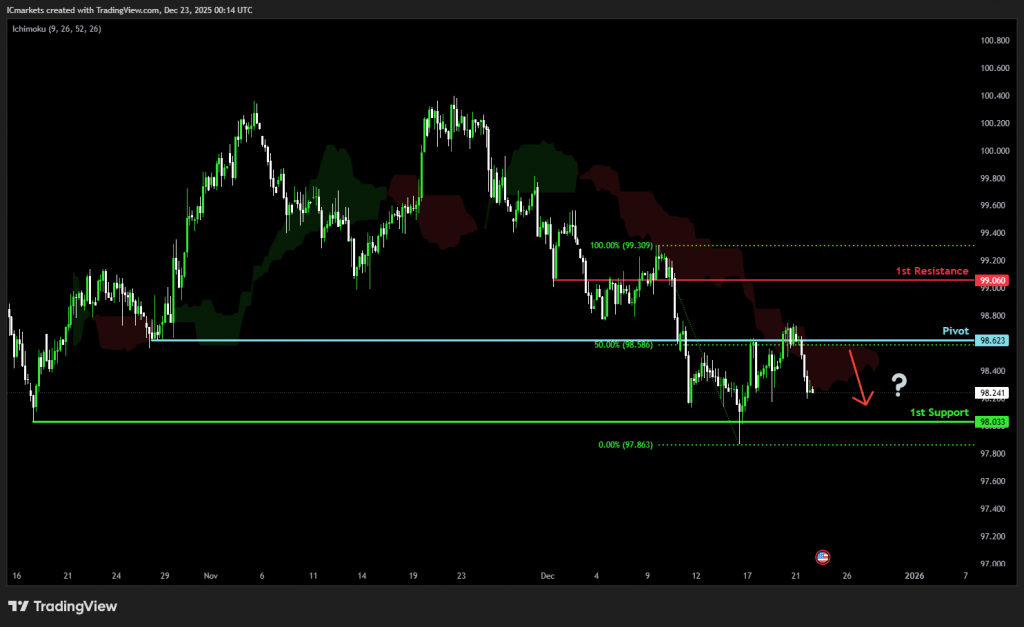
EUR/USD:
Potential Direction: Bullish
Overall momentum of the chart: Bearish
The price has already bounced off the pivot and may continue its bullish move toward the 1st resistance
Pivot: 1.1710
Supporting reasons: Identified as an overlap support, where renewed buying pressure could emerge to push the price higher.
1st support: 1.1644
Supporting reasons: Identified as a pullback support, indicating a potential level where the price could stabilize once again.
1st resistance: 1.1810
Supporting reasons: Identified as a swing high resistance that aligns closely with the 100% Fibonacci projection, indicating a potential level that could cap further upward movement.
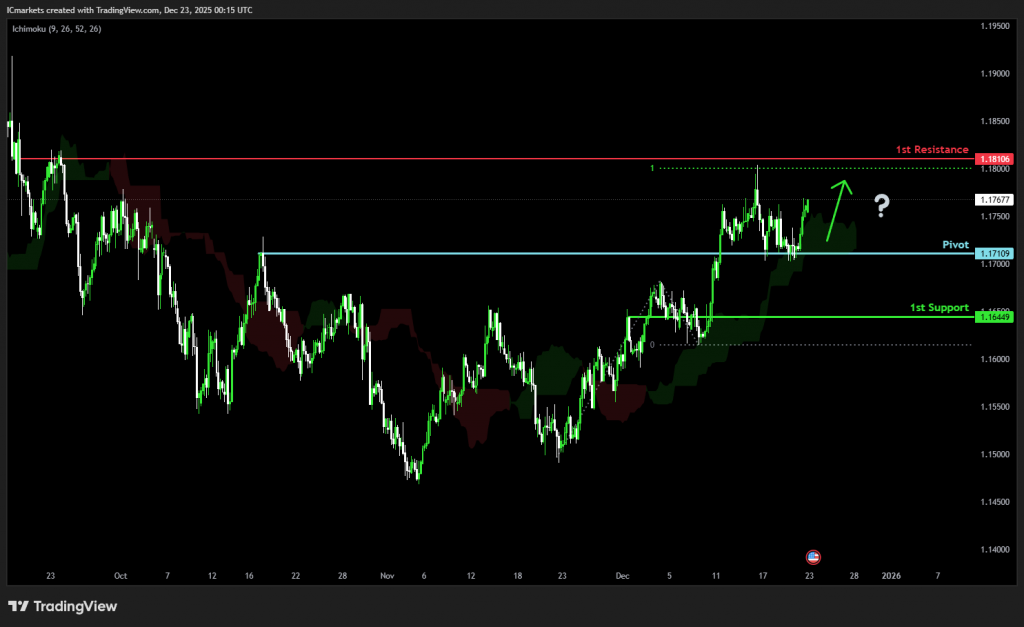
EUR/JPY:
Potential Direction: Bullish
Overall momentum of the chart: Bullish
The price could see a short-term pullback toward the pivot before rising again toward the 1st resistance.
Pivot: 183.02
Supporting reasons: Identified as a pullback support, where renewed buying pressure could emerge to push the price higher.
1st support: 181.69
Supporting reasons: Identified as a pullback support, indicating a potential area where the price could again stabilize.
1st resistance: 185.48
Supporting reasons: Identified as a resistance that is supported by the 127.2% Fibonacci extension, indicating a potential level that could cap further upward movement.
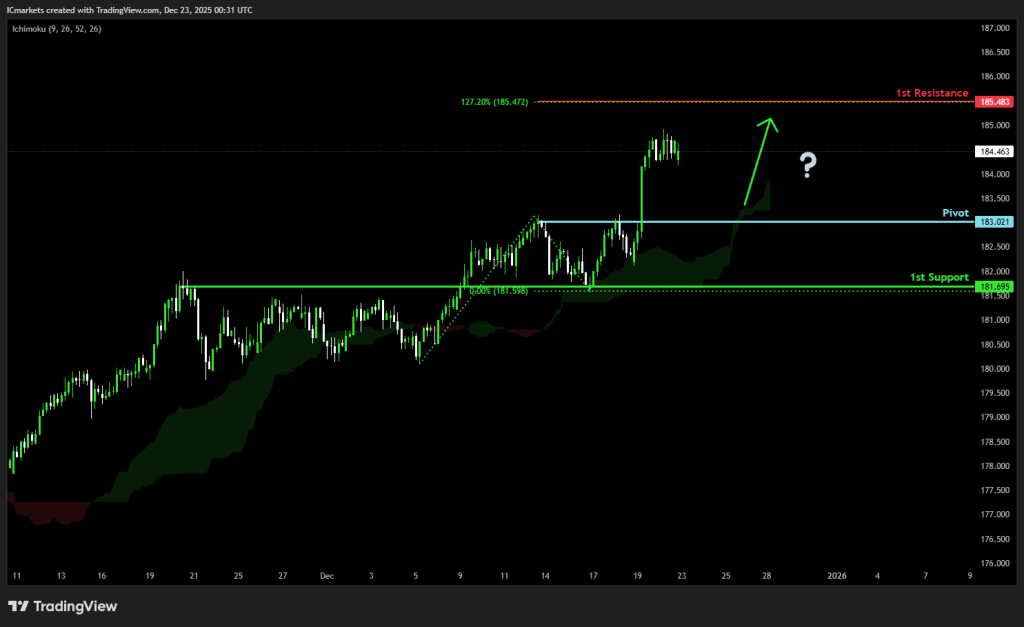
EUR/GBP:
Potential Direction: Bearish
Overall momentum of the chart: Bullish
The price has already reacted off the pivot and may continue its bearish move toward the 1st support.
Pivot: 0.8746
Supporting reasons: Identified as an overlap resistance, where selling pressures could intensify and potentially cap any upward retracement.
1st support: 0.8713
Supporting reasons: Identified as an overlap support, indicating a potential area where the price could stabilize once more.
1st resistance: 0.8799
Supporting reasons: Identified as an overlap resistance, indicating a potential level that could cap further upward movement.
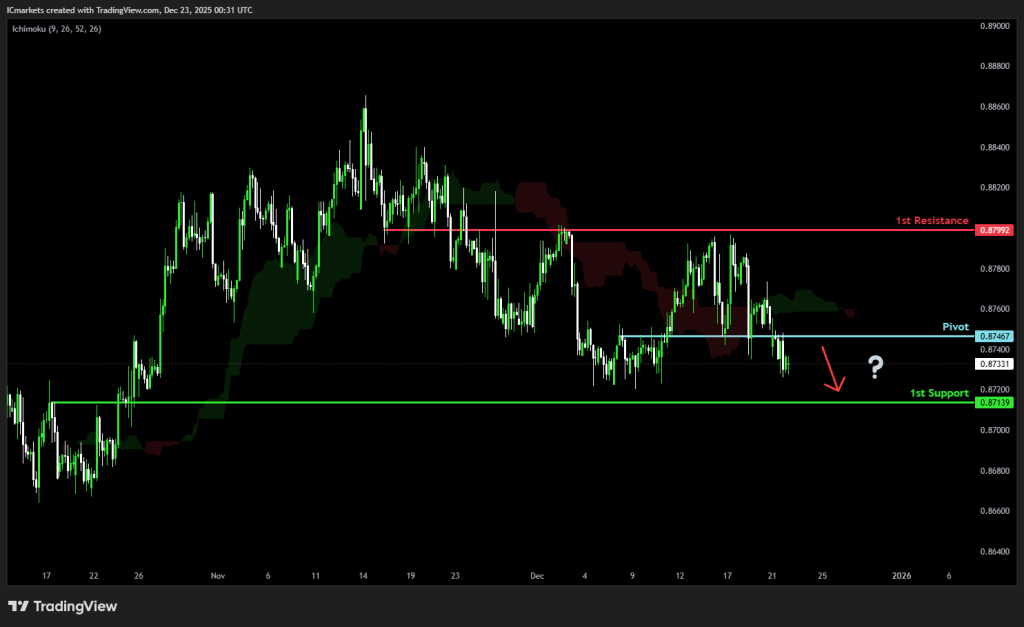
GBP/USD:
Potential Direction: Bullish
Overall momentum of the chart: Bullish
The price has already bounced off the pivot and may continue its bullish move toward the 1st resistance
Pivot: 1.3365
Supporting reasons: Identified as a pullback support, where renewed buying pressure could emerge to push the price higher.
1st support: 1.3268
Supporting reasons: Identified as a pullback support, indicating a potential area where the price could stabilize once more.
1st resistance: 1.3530
Supporting reasons: Identified as a swing high resistance, indicating a potential level that could halt further upward movement.
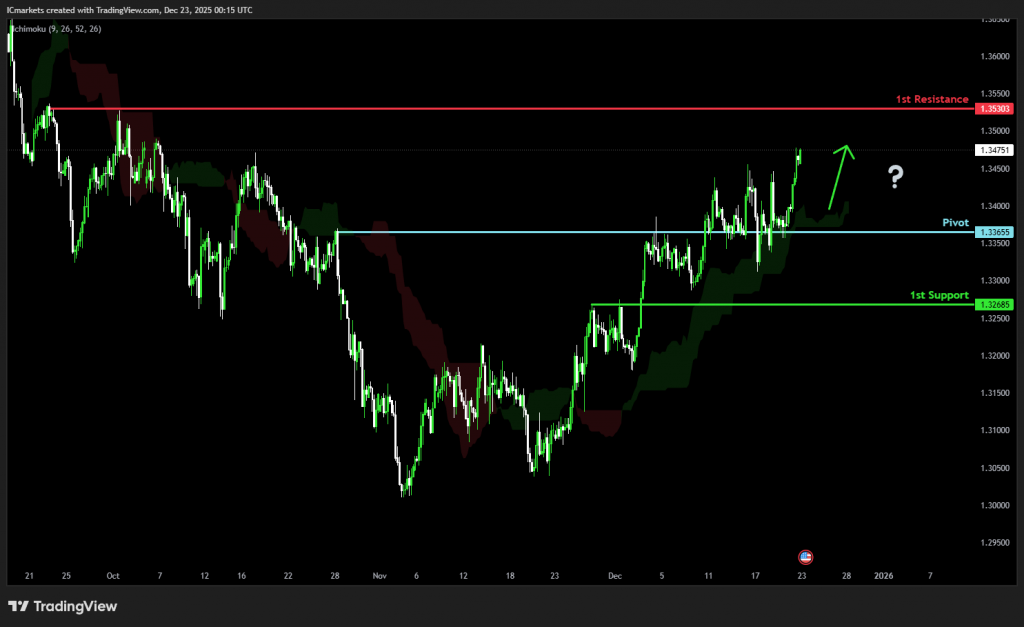
GBP/JPY:
Potential Direction: Bullish
Overall momentum of the chart: Bullish
The price could see a short-term pullback toward the pivot before rising again toward the 1st resistance.
Pivot: 208.94
Supporting reasons: Identified as a pullback resistance, where selling pressures could intensify and potentially cap any upward retracement
1st support: 207.17
Supporting reasons: Identified as an overlap support, indicating a potential level where the price could stabilize once more.
1st resistance: 211.47
Supporting reasons: Identified as a swing high resistance, indicating a potential level that could halt further upward movement.
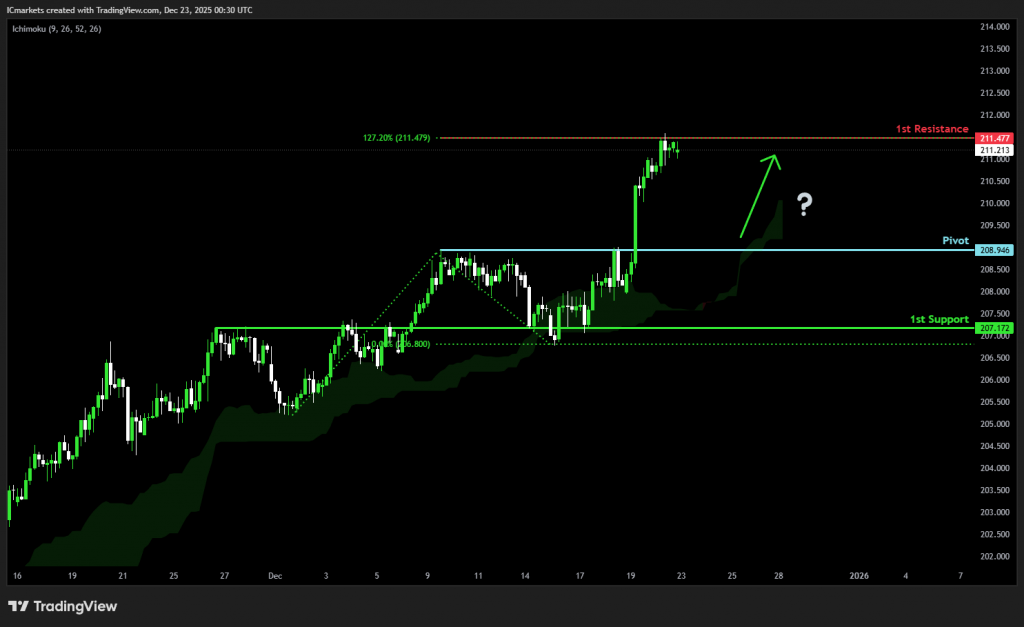
USD/CHF:
Potential Direction: Bearish
Overall momentum of the chart: Bearish
The price could see a short-term pullback toward the pivot before continuing its bearish move down toward the 1st support.
Pivot: 0.7946
Supporting reasons: Identified as a pullback resistance, where selling pressures could intensify and potentially cap any upward retracement.
1st support: 0.7872
Supporting reasons: Identified as a swing low support, indicating a potential level where the price could stabilize once again.
1st resistance: 0.7982
Supporting reasons: Identified as an overlap resistance, indicating a potential level that could cap further upward movement.
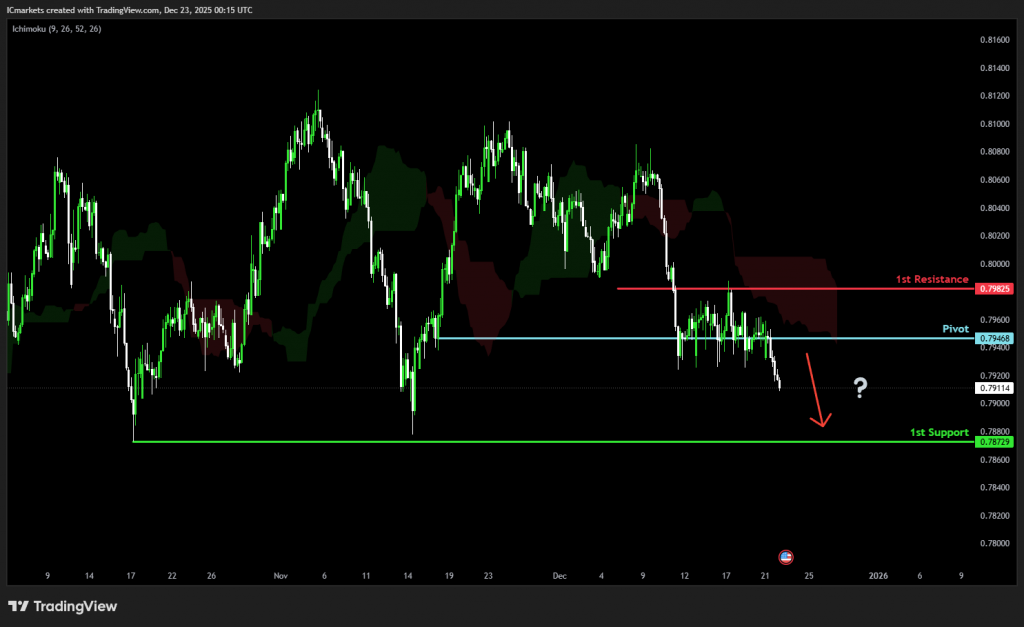
USD/JPY:
Potential Direction: Bullish
Overall momentum of the chart: Bullish
The price could see a short-term pullback toward the pivot before rising again toward the 1st resistance.
Pivot: 157.58
Supporting reasons: Identified as a pullback support, where renewed buying pressure could emerge to push the price higher.
1st support: 154.44
Supporting reasons: Identified as an overlap support, indicating a strong area where buyers might return, and the price could stabilize once again.
1st resistance: 157.58
Supporting reasons: Identified as a swing high resistance. This level represents the next key area where upward movement could be capped amid increased selling pressure
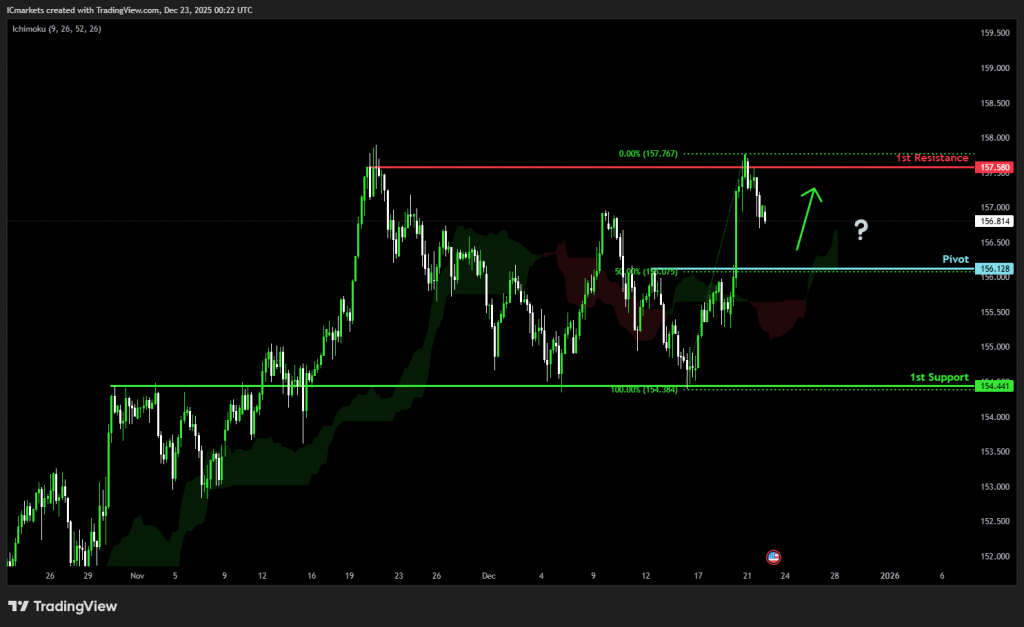
USD/CAD:
Potential Direction: Bearish
Overall momentum of the chart: Bearish
The price could see a short-term pullback toward the pivot before continuing its bearish move down toward the 1st support.
Pivot: 1.3810
Supporting reasons: Identified as a pullback resistance, where selling pressures could intensify and potentially cap any upward retracement.
1st support: 1.3728
Supporting reasons: Identified as a swing low support, indicating a key level where the price could stabilize once more.
1st resistance: 1.3889
Supporting reasons: Identified as a pullback resistance, making it a possible target for bullish advances and a level where some sellers could return to cap gains
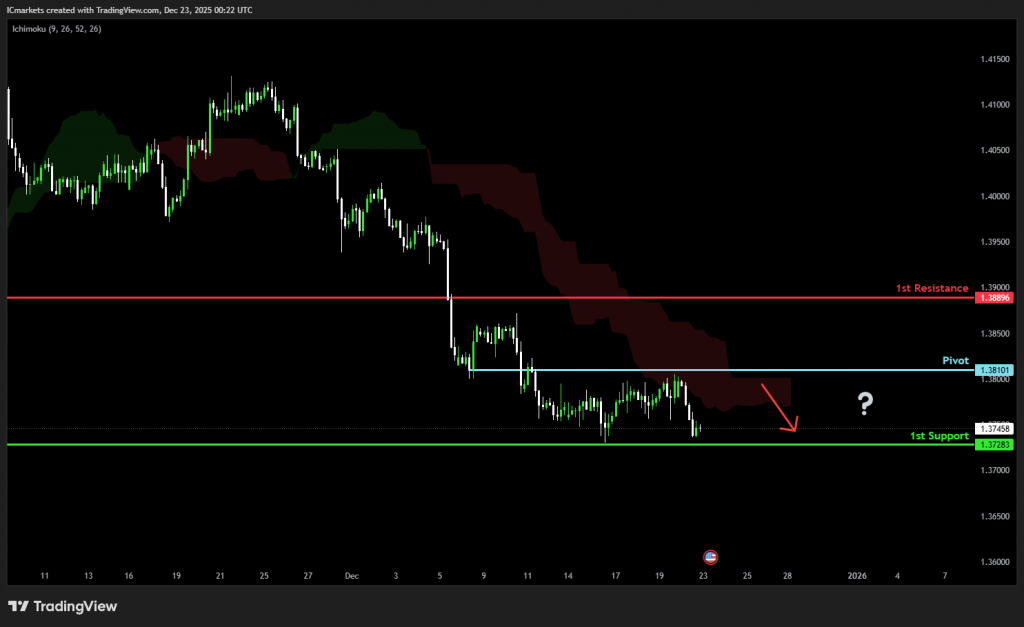
AUD/USD:
Potential Direction: Bullish
Overall momentum of the chart: Bullish
The price could see a short-term pullback toward the pivot before rising again toward the 1st resistance.
Pivot: 0.6622
Supporting reasons: Identified as a pullback support, where renewed buying pressure could emerge to push the price higher..
1st support: 0.6580
Supporting reasons: Identified as a pullback support that aligns with the 38.6% Fibonacci retracement, this area has provided strong support historically and may attract buying interest for a potential short-term bounce
1st resistance: 0.6684
Supporting reasons: Identified as an overlap resistance, indicating a potential area that could halt any further upward movement.
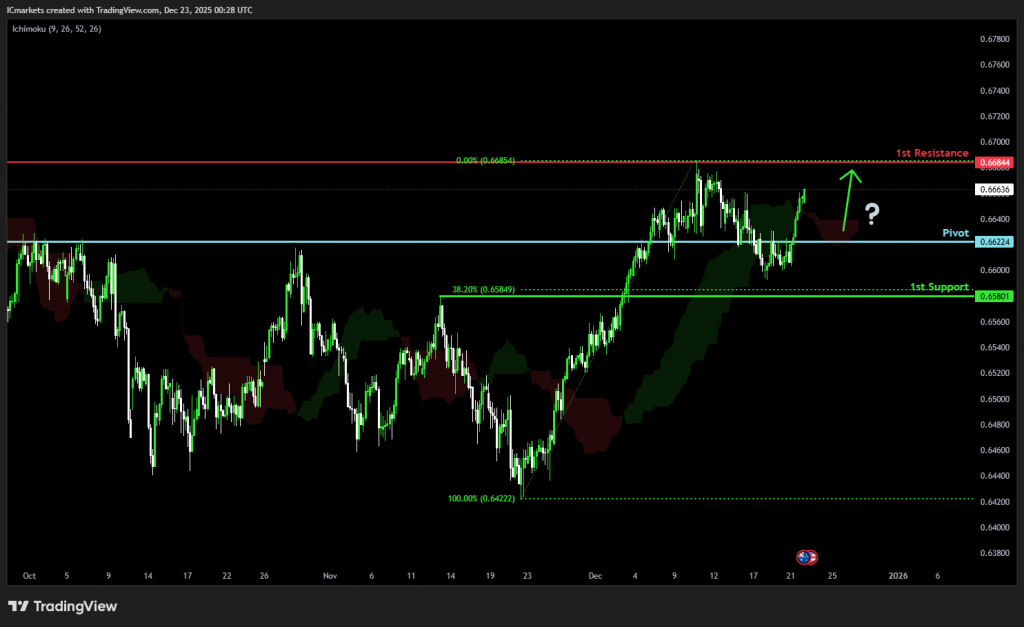
NZD/USD
Potential Direction: Bullish
Overall momentum of the chart: Bullish
The price could see a short-term pullback toward the pivot before rising again toward the 1st resistance.
Pivot: 0.5743
Supporting reasons: Identified as a pullback support, where renewed buying pressure could emerge to push the price higher.
1st support: 0.5743
Supporting reasons: Identified as a pullback support that aligns with the 38.2% Fibonacci retracement, this area has provided strong support historically and may attract buying interest for a potential short-term bounce
1st resistance: 0.5831
Supporting reasons: Identified as a swing high resistance, indicating a potential area that could halt any further upward movement.
US30 (DJIA):
Potential Direction: Bearish
Overall momentum of the chart: Bullish
The price could see a short-term pullback toward the pivot before continuing its bearish move down toward the 1st support.
Pivot: 48,412.06
Supporting reasons: Identified as an overlap resistance, where selling pressures could intensify and potentially cap any upward retracement.
1st support: 47,724.66
Supporting reasons: Identified as a pullback support, suggesting a potential area where the price could stabilize once again.
1st resistance: 48,879.50
Supporting reasons: Identified as a swing high resistance, indicating a potential area that could halt any further upward movement.

DE40 (DAX):
Potential Direction: Bullish
Overall momentum of the chart: Bullish
The price could see a short-term pullback toward the pivot before rising again toward the 1st resistance.
Pivot: 24,105
Supporting reasons: Identified as a pullback support, where renewed buying pressure could emerge to push the price higher.
1st support: 23,860.89
Supporting reasons: Identified as an overlap support, indicating a key level where the price could stabilize once more.
1st resistance: 24,511.92
Supporting reasons: Identified as a swing high resistance, indicating a potential area that could halt any further upward movement.

US500 (S&P 500):
Potential Direction: Bullish
Overall momentum of the chart: Bullish
The price could see a short-term pullback toward the pivot before rising again toward the 1st resistance.
Pivot: 6.828.80
Supporting reasons: Identified as a pullback support, where renewed buying pressure could emerge to push the price higher.
1st support: 6,714.05
Supporting reasons: Identified as an overlap support, indicating a potential level where the price could stabilize once again.
1st resistance: 6,923.08
Supporting reasons: Identified as a swing low resistance, indicating a potential area that could halt any further upward movement.

BTC/USD (Bitcoin):
Potential Direction: Bullish
Overall momentum of the chart: Bearish
The price could see a short-term pullback toward the pivot before rising again toward the 1st resistance.
Pivot: 87,889.54
Supporting reasons: Identified as a pullback support, where renewed buying pressure could emerge to push the price higher.
1st support: 81,604.89
Supporting reasons: Identified as a swing low support, indicating a potential level where the price could stabilize once more.
1st resistance: 94,626.23
Supporting reasons: Identified as an overlap resistance that aligns with the 50% Fibonacci retracement, indicating a potential area that could halt any further upward movement.

ETH/USD (Ethereum):
Potential Direction: Bullish
Overall momentum of the chart: Bullish
The price could see a short-term pullback toward the pivot before rising again toward the 1st resistance.
Pivot: 2,959.88
Supporting reasons: Identified as a pullback support, where renewed buying pressure could emerge to push the price higher.
1st support: 2,740.05
Supporting reasons: Identified as a swing low support, indicating a potential level where the price could stabilize once more.
1st resistance: 3,206.26
Supporting reasons: Identified as a pullback resistance, indicating a potential area that could halt any further upward movement.

WTI/USD (Oil):
Potential Direction: Bullish
Overall momentum of the chart: Bullish
The price could see a short-term pullback toward the pivot before rising again toward the 1st resistance.
Pivot: 56.95
Supporting reasons: Identified as a pullback support, where renewed buying pressure could emerge to push the price higher.
1st support: 55.00
Supporting reasons: Identified as a swing low support, indicating a key level where the price could stabilize once more.
1st resistance: 58.55
Supporting reasons: Identified as a pullback resistance, indicating a potential area that could halt any further upward movement.

XAU/USD (GOLD):
Potential Direction: Bullish
Overall momentum of the chart: Bullish
The price could see a short-term pullback toward the pivot before rising again toward the 1st resistance.
Pivot: 4,368.10
Supporting reasons: Identified as a pullback support, where renewed buying pressure could emerge to push the price higher.
1st support: 4,262.94
Supporting reasons: Identified as a pullback support, indicating a key level where the price could stabilize once more.
1st resistance: 4,513.21
Supporting reasons: Identified as a resistance that aligns with the 127.2% Fibonacci extension, indicating a potential area that could halt any further upward movement.

The accuracy, completeness and timeliness of the information contained on this site cannot be guaranteed. IC Markets Global does not warranty, guarantee or make any representations, or assume any liability regarding financial results based on the use of the information in the site.
News, views, opinions, recommendations and other information obtained from sources outside of www.icmarkets.com, used in this site are believed to be reliable, but we cannot guarantee their accuracy or completeness. All such information is subject to change at any time without notice. IC Markets Global assumes no responsibility for the content of any linked site.
The fact that such links may exist does not indicate approval or endorsement of any material contained on any linked site. IC Markets Global is not liable for any harm caused by the transmission, through accessing the services or information on this site, of a computer virus, or other computer code or programming device that might be used to access, delete, damage, disable, disrupt or otherwise impede in any manner, the operation of the site or of any user’s software, hardware, data or property.
The post Tuesday 23rd December 2025: Technical Outlook and Review first appeared on IC Markets | Official Blog.
Tuesday 23rd December 2025: Asian Markets Edge Higher on Wall Street Optimism as Holiday Trading Remains Subdued
424767 December 23, 2025 14:39 ICMarkets Market News
Global Markets:
- Asian Stock Markets : Nikkei down 0.10%, Shanghai Composite up 0.34%, Hang Seng up 0.22% ASX up 1.09%
- Commodities : Gold at $4,518.90 (1.1%), Silver at $69.655 (1.54%), Brent Oil at $62.03 (-0.06%), WTI Oil at $57.94 (-0.12%)
- Rates : US 10-year yield at 4.154, UK 10-year yield at 4.5370, Germany 10-year yield at 2.9044
News & Data:
- (CAD) IPPI m/m 0.9% to 0.3% expected
- (CAD) RMPI m/m 0.3% to 0.6% expected
Markets Update:
Asian stock markets are trading mostly higher on Tuesday, supported by broadly positive cues from Wall Street overnight and continued strength in technology stocks. Regional currencies also firmed against the U.S. dollar. Trading volumes remained light, however, as the absence of major economic data and the Christmas holiday kept many investors on the sidelines. Later in the day, U.S. reports on durable goods orders, GDP, industrial production, and consumer confidence are expected to draw attention.
The Australian market is extending gains for a fourth straight session, with the S&P/ASX 200 rising above the 8,750 level. Financial and technology stocks are leading the advance, while miners and energy shares are also mostly higher. Among major miners, BHP Group and Rio Tinto are gaining more than 1 percent each. The big four banks are all advancing, led by strong gains in Commonwealth Bank. Shares of Goodman Group surged after announcing a major data-centre partnership in Europe. The Australian dollar is trading around $0.667.
Japan’s stock market is modestly higher, extending recent gains. The Nikkei 225 is holding above the 50,400 level, supported by exporters and banks, though losses in technology stocks and index heavyweights are limiting upside. Banking stocks are broadly higher, while select tech names are under pressure. The U.S. dollar is trading in the higher 156-yen range.
Elsewhere in Asia, most major markets are edging higher, while Wall Street closed firmly positive on Monday. European markets ended lower, and crude oil prices surged amid escalating geopolitical tensions.
Upcoming Events:
- 01:30 PM GMT – CAD GDP m/m
- 01:30 PM GMT – USD Prelim GDP q/q
The post Tuesday 23rd December 2025: Asian Markets Edge Higher on Wall Street Optimism as Holiday Trading Remains Subdued first appeared on IC Markets | Official Blog.
Ex-Dividend 23/12/2025
424759 December 22, 2025 17:00 ICMarkets Market News

The post Ex-Dividend 23/12/2025 first appeared on IC Markets | Official Blog.







